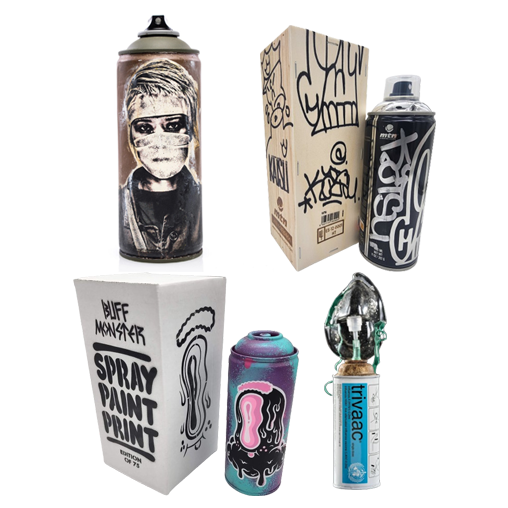
Spray Paint Can Fine Art
-
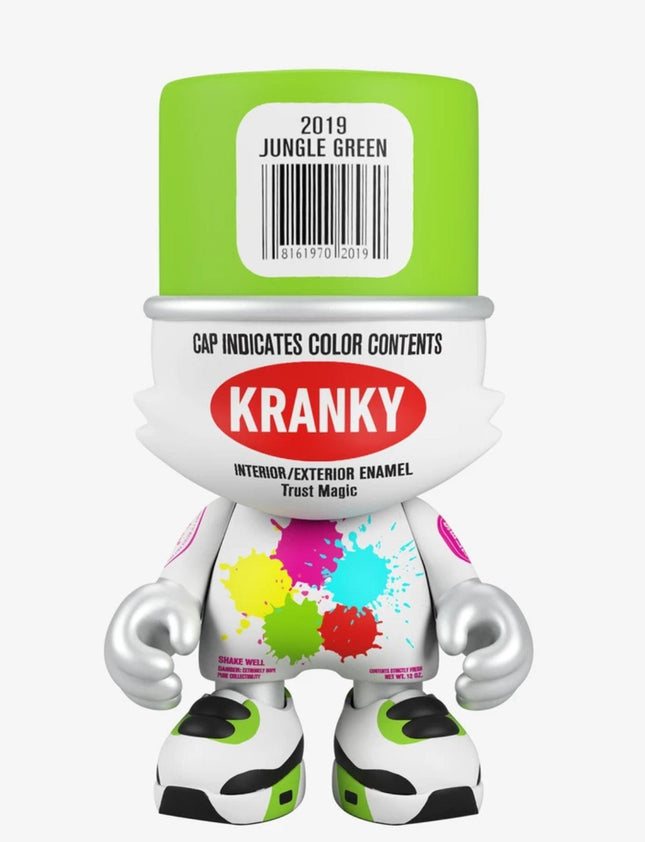
Sket-One Jungle Green SuperKranky SuperPlastic Art Toy by Sket-One
Jungle Green SuperKranky Janky SuperPlastic x Sket One Limited Edition Vinyl Artwork Street Art Toy Collectable Figure 2020 Limited Edition of 666 Sket is back with his dankest drop yet in Jungle Green SuperKranky! Pop off the cap and blaze some green with the super-realistic nozzle. Shake to hear the rattle that has collectors around the world captivated. 8-inches tall, soft vinyl. Just 666 made.
$285.00
-
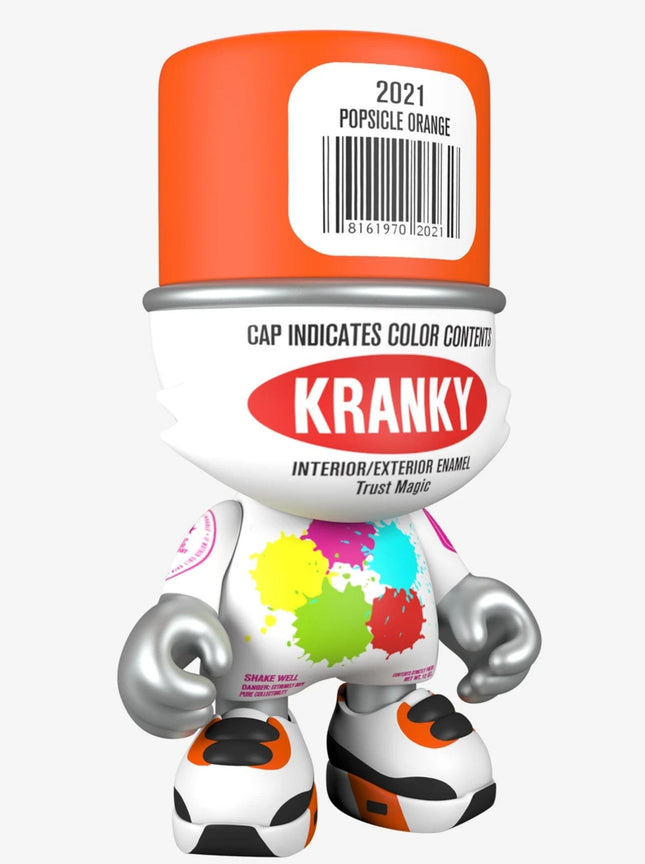
Sket-One Popsicle Orange SuperKranky SuperPlastic Art Toy by Sket-One
Popsicle Orange SuperKranky Janky SuperPlastic x Sket One Limited Edition Vinyl Artwork Street Art Toy Collectable Figure
$291.00
-
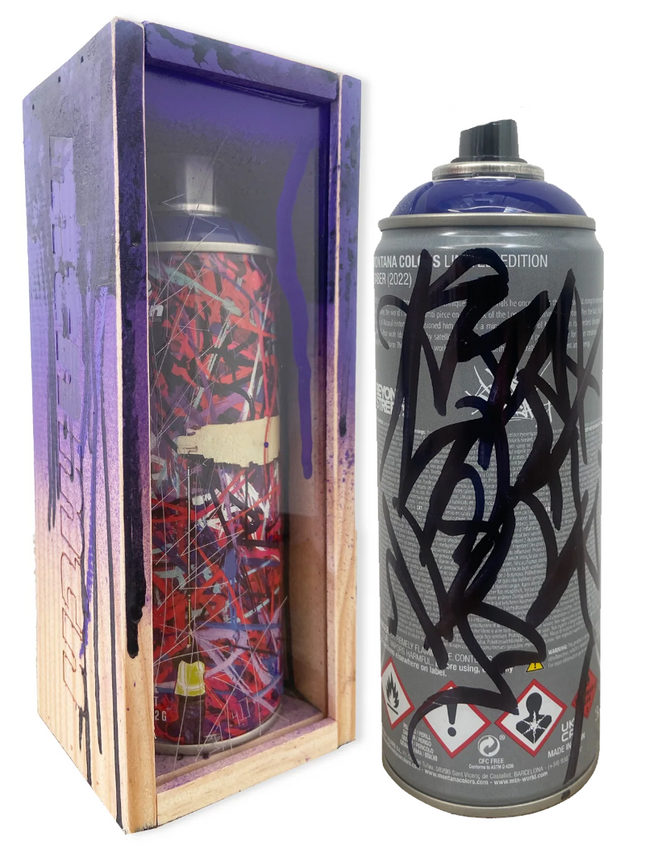
Saber Saber Anonymous Violet HPM Spray Paint Can Artwork by Montana MTN
Saber Anonymous Violet HPM Hand Embellished Limited Edition Rare Spray Paint Can Artwork Crossover by Famous Graffiti Paint Maker Montana MTN. 2023 Spray Paint Can Sign HPM Hand Embellished Print Box Limited Edition of 40 HPM, Limited Amount HPM. Artwork Size 3x8 Can. Limited Edition MTN Spray Can, Montana Colors Spray Paint, Low Pressure Can in Wood, and Acrylic Case Stamped with Saber's tag Spray Paint Color: Anonymous Violet Limited Edition 400ml. The Plexi Glass Cover is Cracked and Broken in 2, Displays Perfect. This was caused by Saber Deeply Scoring The Lid With Graffiti Etchings. The Artistic Alchemy of Spray Paint: Saber Anonymous Violet HPM Edition The Saber Anonymous Violet HPM Hand Embellished Limited Edition spray paint can stand as a testament to the cross-pollination of pop art, street art, and graffiti. This is not just a container of pigment but a piece of art history materialized through the collaboration of Saber, a luminary in the graffiti world, and Montana MTN, the renowned graffiti paint maker. The 2023 edition of this spray paint can is a rare collectible, with each of the 40 pieces being individually signed and hand-embellished by the artist himself, making every can a unique work. Encased in a wood and acrylic box, stamped with Saber's distinctive tag, the artwork is imbued with the essence of the street. The color, Anonymous Violet, is bold, reflecting Saber's preference for impactful, vivid hues in his large-scale murals. The hand-embellished print adoring each can is a hallmark of authenticity and artistic involvement, distinguishing these limited-edition pieces from standard graffiti supplies. This particular series serves as a tool for creating street pop art and graffiti artwork and as a standalone piece of collectible art. The dimensions of the can, standing at 3x8 inches, make it a compact yet significant object. The low-pressure system of the can is designed for fine detail work, accommodating the nuanced techniques of graffiti artists. The "HPM" in the title stands for 'Hand Painted Multiple,' indicating that while the series is a limited edition, each piece has been individually touched by the artist, creating variations that ensure every can is one of a kind. Cultural Relevance of the Saber Anonymous Violet HPM Edition The cultural relevance of the Saber Anonymous Violet HPM spray paint can is multifaceted. In the realm of street pop art and graffiti artwork, the tools of the trade are often as celebrated as the artworks themselves. Montana MTN, with its history of providing quality materials to graffiti artists, has long been recognized within the community. The collaboration with Saber elevates this can to an artifact of the culture, representing the artist's commitment to his craft and the broader graffiti movement.
$236.00
-
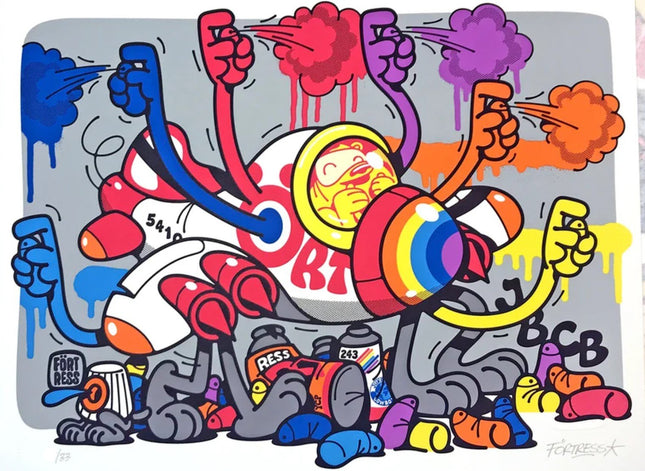
Flying Fortress Airosol Plane Silkscreen Print by Flying Fortress
Airosol Plane Hand-Pulled 9-Color Silkscreen Print on 300gsm Conqueror Cotton Paper by Pop Graffiti Artist Flying Fortress Rare Street Art Limited Edition Artwork. 2020 Signed & Numbered Limited Edition of 33 Artwork Size 15.8x11.8
$291.00
-
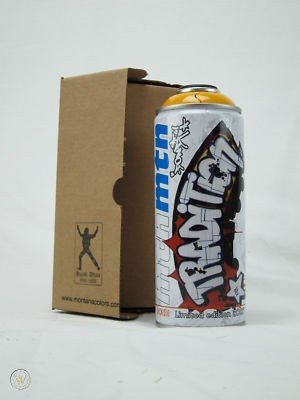
Dondi White Dondi Middle Yellow Spray Paint Can Artwork by Montana MTN
Dondi- Middle Yellow Limited Edition Rare Spray Paint Can Artwork Crossover by famous graffiti paint maker Montana MTN. Dondi White Foundation X Winery. This limited edition is special not only for the artist he represents but for the purpose to which he is directed. In this case, Boston's legendary store, Bodega, promotes a project with which to pay tribute to who was undoubtedly one of the fundamental writers to understand the history of graffiti: Dondi White, and with which to raise funds for Foundation, which has been helping AIDS-affected since 2003.
$218.00
-
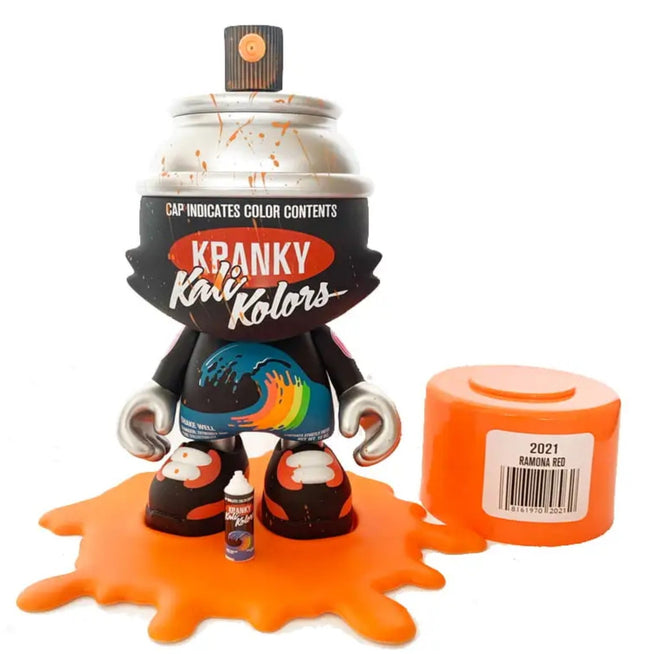
Sket-One Ramona Red AP SuperKranky HPM Art Toy by Sket- One x SuperPlastic
Ramona Red Artist Proof SuperKranky Set Limited Edition Vinyl Artwork Street Art Toy Collectable Figure by Sket- One AP Artist Proof 2022 Signed & Numbered Edition of Only 10 Jankey Superplastic Custom Super Kranky Hand Made Parts by Sket One. Comes Hand Embellished with Paint Pool Underlayment 7 Mini Spray Can Element. These pieces come with: Custom paint splatter (Each one will be unique) 3d Resin Puddle Place Matt Resin Kranky Spraycan Signed and Numbered on Cap
$572.00
-
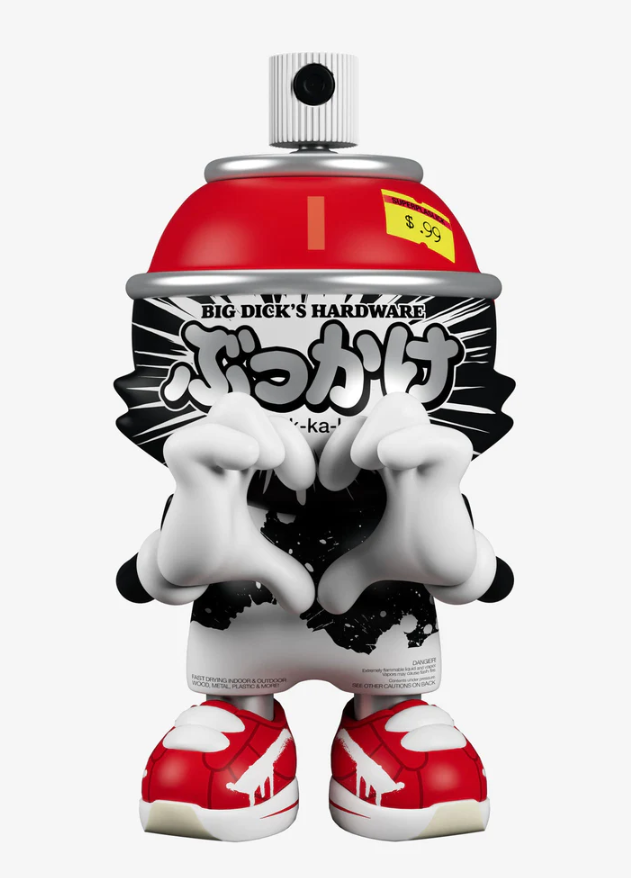
OG Slick Love Red SuperKranky SuperPlastic Art Toy by OG Slick
Love Red SuperKranky SuperPlastic Art Toy by OG Slick Limited Edition Janky Vinyl Art Toy Collectible Artwork by Modern Design Artist x Sket-One x Big Dicks Hardware. 2023 Limited Run of 1111 SuperKranky Janky Superplastic Vinyl Art Toy Artwork Size 6x8 New In Box. Based on OG Slick's BDH Big Dicks Hardware Bukkake Spray Paint. The Love Red SuperKranky is an art toy designed by OG Slick in collaboration with SuperPlastic, a leading designer toy company known for producing high-quality vinyl toys in limited editions. OG Slick is an iconic graffiti artist from Los Angeles who has made a name for himself in the street art and urban vinyl toy scene. His distinctive style blends street culture and fine art, creating visually striking and memorable pieces. The Love Red SuperKranky is a vinyl toy featuring the signature character "SuperKranky," which takes inspiration from a spray paint can. This particular edition comes in a bright, bold red color with black and white accents, showcasing OG Slick's graffiti-style artwork. The toy features movable parts and usually comes with additional accessories like a removable cap and a "rattle" sound, emulating the sound of a real spray paint can. As with most art toys, the Love Red SuperKranky by OG Slick and SuperPlastic is produced in limited quantities, making it highly sought after by collectors and fans of the artist's work. Its unique design and connection to street art make it a popular item in the urban vinyl toy community.
$369.00
-
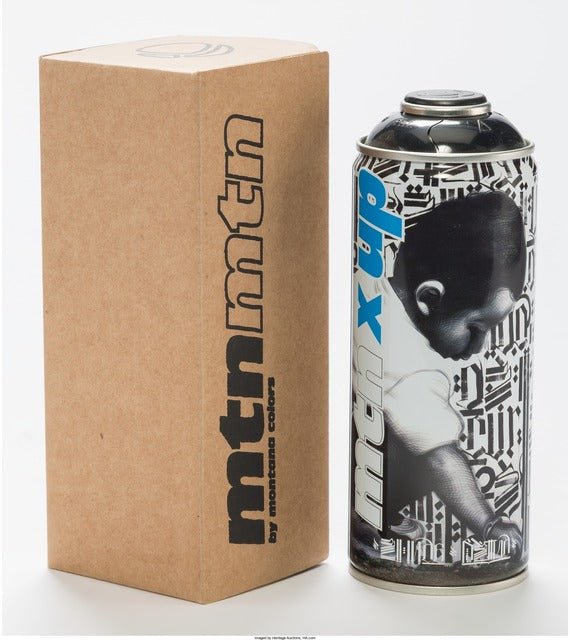
Retna Mac & Retna Black Spray Paint Can Artwork by Montana MTN
Mac & Retna- Black Limited Edition Rare Spray Paint Can Artwork Crossover by famous graffiti paint maker Montana MTN. Each of these artists has developed their own distinctive style and technique; Retna is best known for his bold calligraphic brushstrokes, and Mac for his painting of faces and figures that seem real; The Mac uses spray paint and Retna uses a spray and acrylic paint for its paints; oil, acrylic, enamel, pencil, and other media on paper, canvas, and wood.
$218.00
-
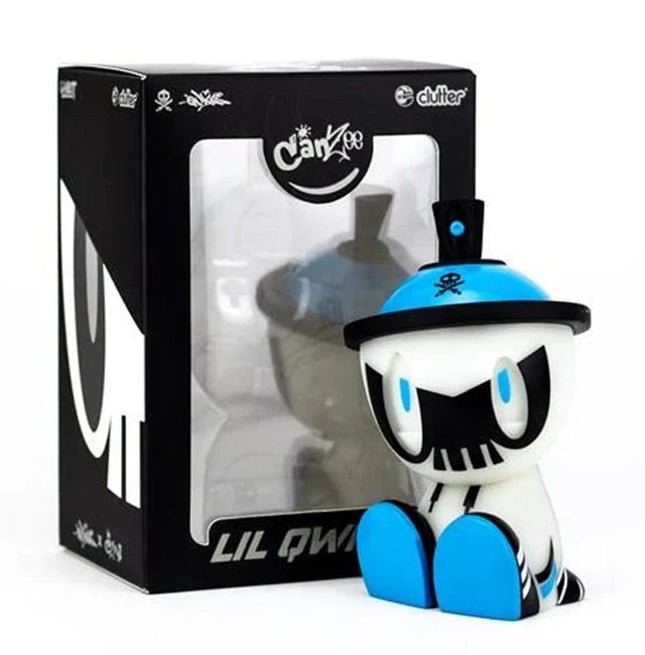
Quiccs Ghost Lil Qwiky GID 5oz Canbot Canz Art Toy Figure by Quiccs x Czee13
Ghost Lil Qwiky GID 5oz Canbot Canz Limited Edition Vinyl Art Toy Collectible Artwork by street graffiti Quiccs x Czee13. 2021 Limited Edition Displayed In Box Get ready to GLOW! The FIRST Glow-in-the-dark Canbot Canz designed by Philippines legend QUICCS!Over the last few years, Quiccs has blazed a path through the art world, and for this All Hallows Eve he has teamed up with Czee13 and the crew at Clutter, to bring you the spookiest of the Lil Qwikys… The GID GHOST! Standing at 5.5” with its trademark rattle, the Ghost glows with a very special Blue Hue! This is the FIRST of the Canbot Canz releases that is GLOW-IN-THE-DARK.
$179.00
-
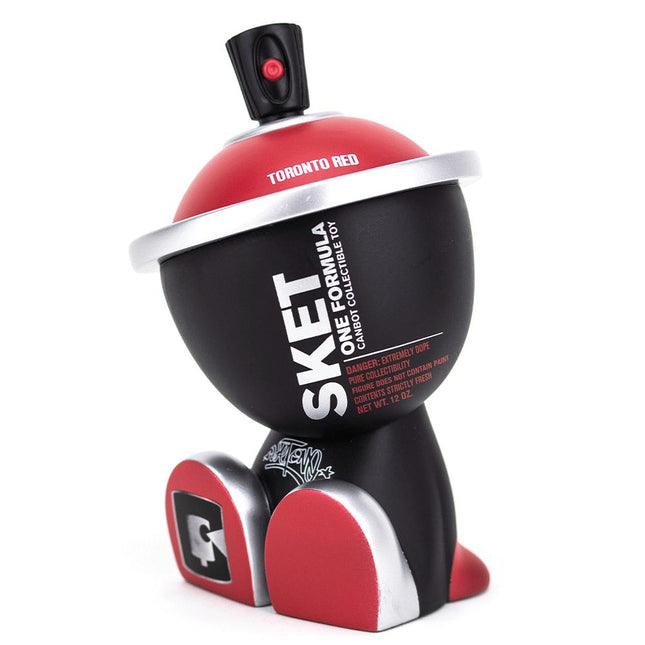
Sket-One Toronto Red Canbot Canz Art Toy Figure by Sket-One x Czee13
Toronto Red Canbot Canz Limited Edition Vinyl Art Toy Collectible Artwork by street graffiti Sket-One, Toronto Collective Exclusive. 2021 Box Stamped Size 5.5" Limited Edition of 250 Displayed In Box "Sket One has teamed up with Czee13 & Clutter to bring you a killer series of Canz that are Classics. The third of the new series of Canz by Sket-One is the Toronto Red One Formula releasing exclusively through Toronto Collective Standing at 5.5” with its trademark rattle, this dope Canbot Canz fits perfectly with the rest of the Canz family! Limited to 250 pieces worldwide!" -Clutter
$184.00
-
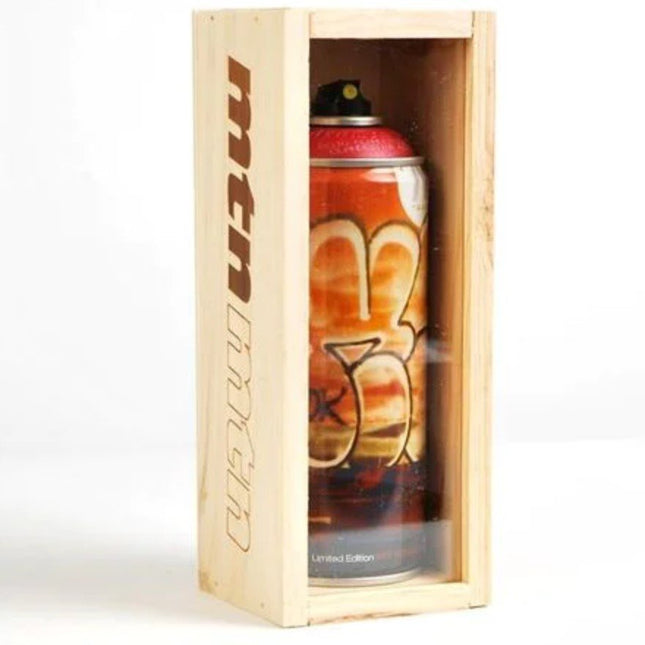
KET RIS KET RIS Oxide Red Spray Paint Can Artwork by Montana MTN
KET RIS- Oxide Red Limited Edition Rare Spray Paint Can Artwork Crossover by famous graffiti paint maker Montana MTN. Ket is an active graffiti artist, curator, and photographer. Most recently he was the curator for graffiti and street art-related exhibitions at Fondation Cartier in Paris, PowerHouse Arena in Brooklyn, 55DSL in New York City, The Hip Hop Theatre Festival at New York University, and the MOCA in Los Angeles. He has painted around the world in places such as Melbourne, Port Au Prince, Copenhagen, and Lima, Peru.
$218.00
-
![[Not]WhiteChoc Bunnybot Canbot Canz Art Toy by Czee13](//sprayedpaint.com/cdn/shop/products/notwhitechoc-bunnybot-canbot-canbot-818644.jpg?v=1667828553&width=645)
Czee13 [Not]WhiteChoc Bunnybot Canbot Canz Art Toy by Czee13
[Not]WhiteChoc Bunnybot Canbot Canz Limited Edition Vinyl Art Toy Collectible Artwork by Street Graffiti Artist Czee13. 2022 Limited to 20 Solid 5oz Canbot Canz , New In Box. Sculpted by Czee13! Designed to look just like your favorite easter white chocolate bunny, complete with a side seam! Each of these pieces is lovingly hand-created in New York by Clutter Studios! This is a limited edition run of 20 pieces. Does Not Rattle.
$480.00
-
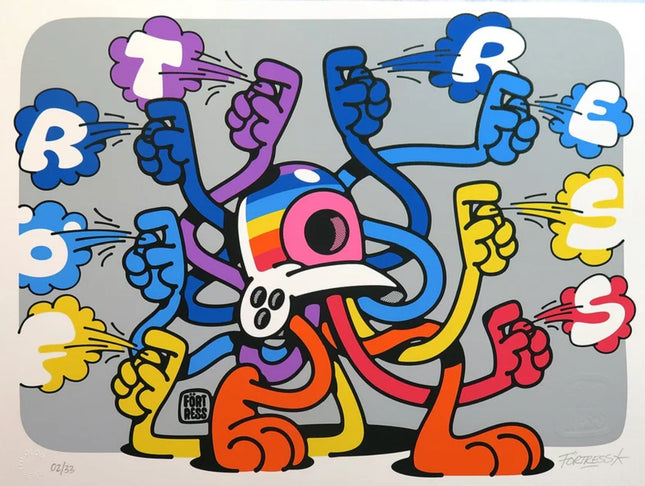
Flying Fortress Squidron Trooper Silkscreen Print by Flying Fortress
Squidron Trooper Hand-Pulled 9-Color Silkscreen Print on 300gsm Conqueror Cotton Paper by Pop Graffiti Artist Flying Fortress Rare Street Art Limited Edition Artwork. 2020 Signed & Numbered Limited Edition of 33 Size 15.8x11.8 Flying Fortress's "Squadron Trooper": A Symphony in Street Pop Art The "Squidron Trooper" by Flying Fortress is a vibrant example of how graffiti's urban grit intertwines with pop art's playful essence. This hand-pulled 9-color silkscreen print on 300gsm Conqueror Cotton Paper is part of a rare and exclusive series, with only 33 signed and numbered editions available worldwide. Measuring 15.8x11.8 inches, the 2020 artwork is a testament to the enduring appeal of Street Pop Art and Graffiti Artwork, and it embodies the distinct aesthetic that Flying Fortress, a notable Pop Graffiti Artist, is celebrated for. Flying Fortress, the pseudonym of the German artist, has left a permanent mark on the urban art scene. His work is distinguished by a recurring theme of whimsical characters, often depicted in dynamic compositions that capture the motion and chaos of city life. In "Squidron Trooper", the fusion of graffiti art's boldness and pop art's iconography delivers a powerful visual punch. Technical Mastery and Creative Vision The technical aspects of "Squadron Trooper" reflect the meticulous nature of Flying Fortress's artistic process. Silkscreen printing, known for its capacity to produce vibrant colors and intricate details, is ideally suited to the artist's style. Conqueror Cotton Paper, a substrate prized for its luxurious texture and strength, further enhances the artwork's visual impact, offering a tactile quality that deepens the viewer's engagement with the piece. The choice of nine colors is significant, offering a complexity and depth to the print often found in street art. This layering of colors, each pulled by hand, ensures that every piece within the edition has slight variations, making each print unique. The colorful, bold lines of "Squadron Trooper" exude an energy symbolic of the urban landscapes from which street art emanates. Flying Fortress's Cultural Contribution Flying Fortress has long been a proponent of integrating street culture into the broader artistic narrative. With "Squidron Trooper", the artist invites us to reflect on the intersections between street art and mainstream culture. Like much of his oeuvre, this artwork blurs the lines between high and low art, urging a reevaluation of artistic hierarchies. The artwork's resonance in the Street Pop Art and Graffiti Artwork scene can be attributed to its distinctive blend of accessible imagery and complex craftsmanship. It is a narrative of creativity that traverses beyond the confines of traditional graffiti, placing Flying Fortress at the forefront of artists who champion the Street Pop Art movement. "Squadron Trooper" is a visually arresting piece and a medium through which Flying Fortress continues influencing the evolving street art landscape.
$291.00
-
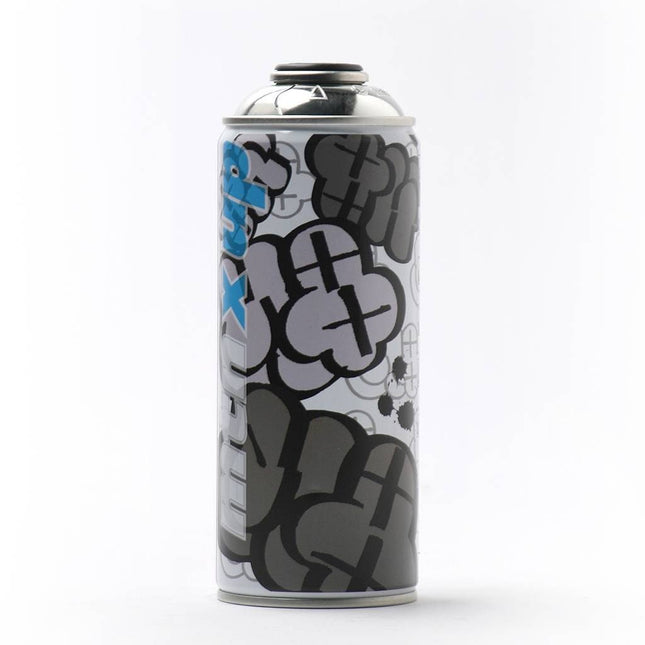
MQ Planet- Mque MQ Chrome Silver Spray Paint Can Artwork by Montana MTN
MQ- Chrome Silver Limited Edition Rare Spray Paint Can Artwork Crossover by famous graffiti paint maker Montana MTN. No Box 2009 MQ Planet- Mque x Montana MTN Spray Paint. For more than a decade, the New York City-born artist has made a name for himself in graffiti by not being afraid and staying true to street culture. The distinctive style of MQ letters has influenced a generation of bombers. His work can be found from the sides of ships in San Francisco to the brick walls of New York City. MQ Chrome Silver Limited Edition: A Monument in Street Pop Art In the dynamic sphere of street pop art and graffiti artwork, the MQ Chrome Silver Limited Edition Spray Paint Can is a testament to the fusion of artistic ingenuity and cultural influence. This rare piece, a crossover project by the acclaimed graffiti paint maker Montana MTN, marks a significant point in the career of the New York City-born artist MQ Planet, or by his real name, Mque. Since its inception in 2009, this limited edition spray paint can have become a symbol of Mque's fearless approach to street culture and his lasting impact on a generation of graffiti artists, or 'bombers,' as often referred to. Mque's Influence on Street Art and Graffiti Mque's journey in graffiti began on the vibrant streets of New York City, where he honed his distinctive style of MQ letters, a style that would come to influence countless others. His bold, unapologetic approach to art was characterized by embracing street culture in its rawest form. Mque's artwork, spanning from the maritime canvases of ships in San Francisco to the historic brick walls of New York, showcases his adaptability and commitment to the essence of street art. The Chrome Silver Limited Edition spray paint can is not just a tool but a piece of history, embodying the spirit and tenacity of the artist. The Significance of the MQ Chrome Silver Limited Edition Can The MQ Chrome Silver Limited Edition spray paint can by Montana MTN is more than an artist's signature on a product; it is a collaborative emblem of the street art community. This rare item encapsulates the synergy between artist and manufacturer, highlighting Montana MTN's recognition of Mque's contribution to the art form. Collectors and admirers of street pop art and graffiti artwork see the can as a collector's item. Still, for a pra beacon of inspiration, urging practitioners to push boundaries and make their mark with the same daring spirit Mque displayed. In the world of street pop art, where the cityscape becomes a canvas and the spray can a paintbrush, the MQ Chrome Silver Limited Edition is a tribute to the ever-evolving narrative of graffiti. It honors the legacy of an artist who stayed true to the ethos of street culture and yet managed to leave an indelible mark on its history. Mque's work, his collaboration with Montana MTN, and the resulting Chrome Silver spray paint remain pivotal in the discourse of street pop art and graffiti artwork for years to come.
$218.00
-
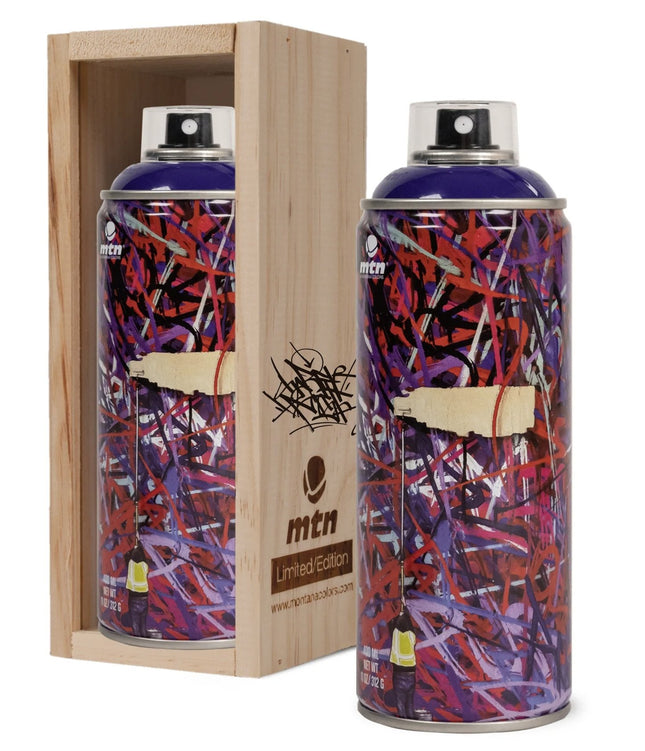
Saber Saber Anonymous Violet Spray Paint Can Artwork by Montana MTN
Saber Anonymous Violet HPM Hand Embellished Limited Edition Rare Spray Paint Can Artwork Crossover by Famous Graffiti Paint Maker Montana MTN. 2023 Spray Paint Can Sign HPM Hand Embellished Print Box Limited Edition of 500, Limited Amount HPM. Artwork Size 3x8 Can. Limited Edition MTN Spray Can, Montana Colors Spray Paint, Low Pressure Can in Wood, and Acrylic Case Stamped with Saber's tag Spray Paint Color: Anonymous Violet Limited Edition 400ml. ! The Artistic Alchemy of Spray Paint: Saber Anonymous Violet HPM Edition The Saber Anonymous Violet HPM Hand Embellished Limited Edition spray paint can stand as a testament to the cross-pollination of pop art, street art, and graffiti. This is not just a container of pigment but a piece of art history materialized through the collaboration of Saber, a luminary in the graffiti world, and Montana MTN, the renowned graffiti paint maker. The 2023 edition of this spray paint can is a rare collectible, with each of the 500 pieces being individually signed and hand-embellished by the artist himself, making every can a unique work. Encased in a wood and acrylic box, stamped with Saber's distinctive tag, the artwork is imbued with the essence of the street. The color, Anonymous Violet, is bold, reflecting Saber's preference for impactful, vivid hues in his large-scale murals. The hand-embellished print adoring each can is a hallmark of authenticity and artistic involvement, distinguishing these limited-edition pieces from standard graffiti supplies. This particular series serves as a tool for creating street pop art and graffiti artwork and as a standalone piece of collectible art. The dimensions of the can, standing at 3x8 inches, make it a compact yet significant object. The low-pressure system of the can is designed for fine detail work, accommodating the nuanced techniques of graffiti artists. The "HPM" in the title stands for 'Hand Painted Multiple,' indicating that while the series is a limited edition, each piece has been individually touched by the artist, creating variations that ensure every can is one of a kind. Cultural Relevance of the Saber Anonymous Violet HPM Edition The cultural relevance of the Saber Anonymous Violet HPM spray paint can is multifaceted. In the realm of street pop art and graffiti artwork, the tools of the trade are often as celebrated as the artworks themselves. Montana MTN, with its history of providing quality materials to graffiti artists, has long been recognized within the community. The collaboration with Saber elevates this can to an artifact of the culture, representing the artist's commitment to his craft and the broader graffiti movement.
$226.00
-
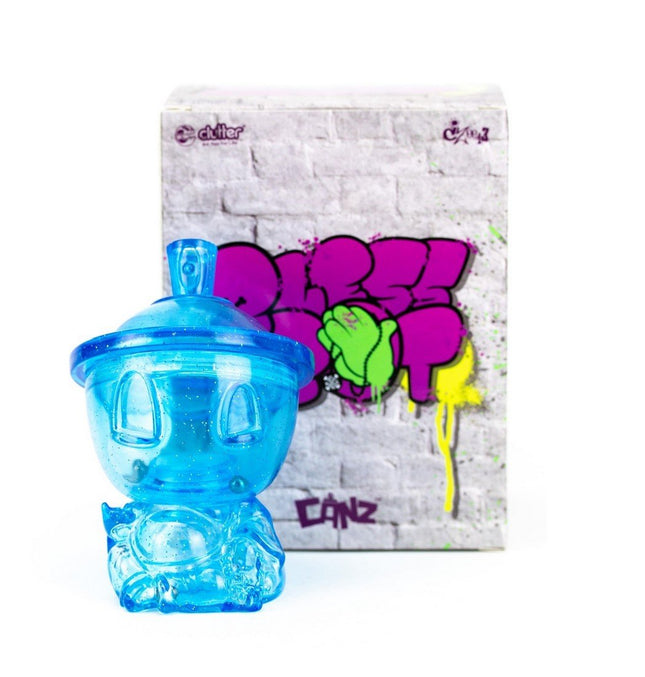
Czee13 Blessbot- Crystal Blue Canbot Canz Art Toy by Czee13
Blessbot- Crystal Blue Canbot Canz Limited Edition Vinyl Art Toy Collectible Artwork by street graffiti Czee13. 2021 Limited Edition of 100 Artwork Cast in clear blue vinyl with mystical glitter, the alternate sculpt of the 5oz canbot features a meditating guru with prayer beads in a seated pose with shaka gesture. As with all canbots, the Blessbot features the coveted spray can rattle. An edition of 100, the Blessbot – Crystal Blue soft vinyl art toy (5.5″) Displayed With Box.
$204.00
-
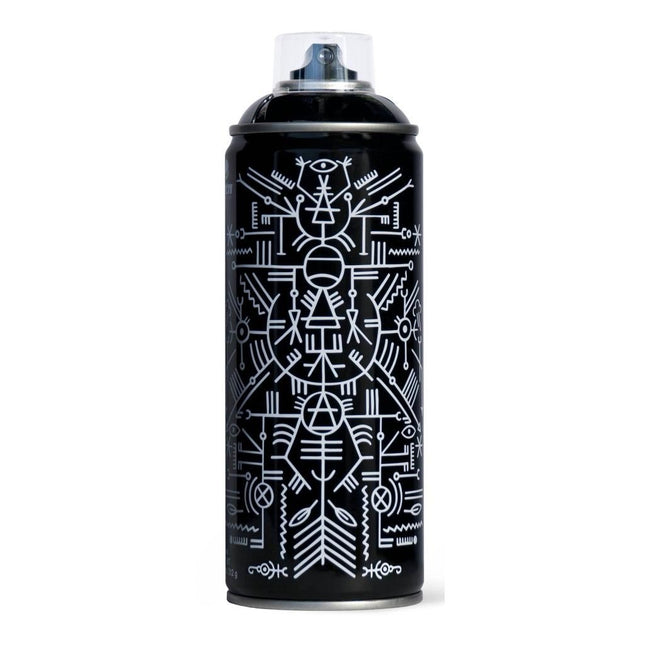
Grems Grems Black Spray Paint Can Artwork by Montana MTN
Grems- Black Limited Edition Rare Spray Paint Can Artwork Crossover by famous graffiti paint maker Montana MTN. The complete artist with overflowing energy, Grems is this kind of unstoppable artist, that will always push the boundaries til the end. His 2 main creative tendencies, Art and Music, developed alongside one another, are teasing and forcing each other to more energetic production in order to always create something unexpected while keeping his well-known and unique style. Hugely active and super productive, his unbridled creativity has made his CV read more like War and Peace: 6 solo albums, 8 releases in collaboration with Klub sandwich, Disiz, Rouges à Lèvre, Olympe, PMPDJ, Foreign Beggars, 15 music videos, multiple art exhibitions spanning the globe, including Peking, Perth, Sevilla, Mexico, London, Paris, Marseille, etc., many walls covered by his graffs including Southbank Centre in London, Beaubourg/ Museum of Pompidou, (the most prestigious modern art museum in France), collaborations with brands such as Skullcandy, Nike, Swatch, Asics, Converse, Scott and Sixpack to name just a few. Grems has also somehow managed to find time to create Ussle, his own apparel brand.
$218.00
-
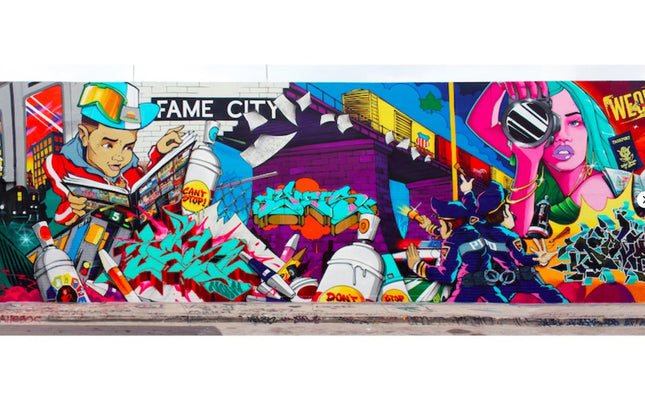
Ces One- Rob Provenzano Fame City Giclee Print by Ces
Fame City Pop Street Artwork Limited Edition Giclee Print on 310gsm Canson Infinity Rag Photographique Paper by Urban Graffiti Modern Artist Ces One- Rob Provenzano x Doves x Mast x Yes2. 2020 Signed & Numbered By All 4 Artists Limited Edition of 100 Artwork Size 36x12 "Fame City,” depicts a mural painted in Wynwood.
$631.00
-
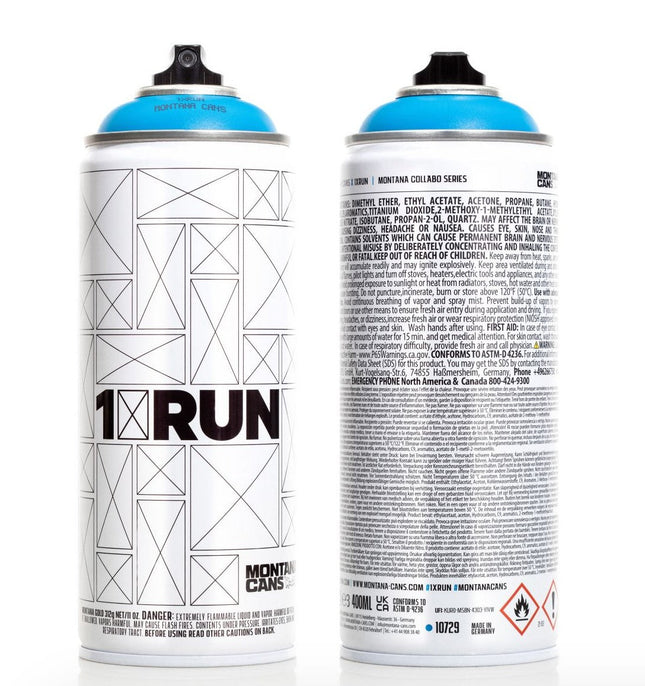
Montana MTN 1XRUN Official Collab Blue Magic Spray Paint Can Artwork by Montana MTN
1XRUN Official Collab- Blue Magic Limited Edition Rare Spray Paint Can Artwork Crossover by famous graffiti paint maker Montana MTN. Montana Gold Acrylic Professional Spray Paint in Blue Magic Size: 400ml (11 oz) Release: November 24, 2021 The Montana Cans 1XRUN collabo can celebrates the 11th anniversary of the Detroit-based 1XRUN publishing house. Supporting artists and collectors of art since 2010, 1XRUN is famous for its limited-edition single-run original artists prints. What better way to signify such a moment than to create a limited edition Montana Cans collabo can in the premium quality Montana GOLD color, Magic Blue. Loaded with the Montana Skinny Cap black/black, the can is not only the iconic graffiti and mural making tool of precision, but it also becomes a collectible can for any purveyor of contemporary art. Featuring the famous x-frame symbol from the 1XRUN logo, this can is bound to become part of international aerosol can history.
$134.00
-
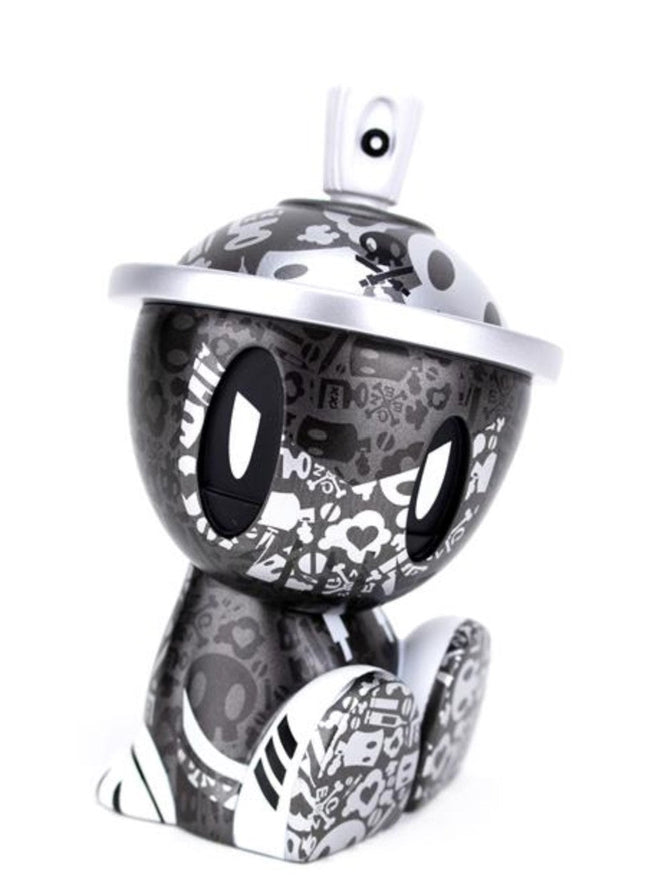
Quiccs VSOG Silver Canbot Canz Art Toy Figure by Quiccs x Czee13
VSOG Silver Canbot Canz Limited Edition Vinyl Art Toy Collectible Artwork by street graffiti Quiccs x Czee13. 2021 Limited to 300, the VSOG Silver Canbot Canz is the second & final colorway of the VSOG Canbot Canz . Displayed In Box
$179.00
-
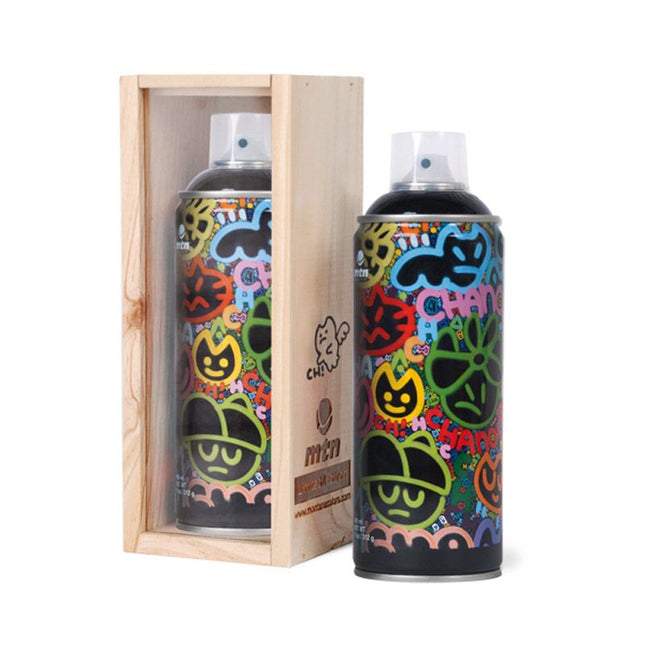
Chanoir Chanoir Black Spray Paint Can Artwork by Montana MTN x
Chanoir- Black Limited Edition Rare Spray Paint Can Artwork Crossover by famous graffiti paint maker Montana MTN. Chanoir is a street artist originally from Colombia and currently living in Paris who builds his work around the iconic figure of “The Black Cat”. His playful style surprises pedestrians in cities like Bogota, Miami, and Barcelona, to name just a few. During his stay in Barcelona, where he lived for many years, he founded The 1980 Crew, one of the most active groups in the beginning of the century. This time period being commonly thought of as the so-called “Golden Era” of street art in Barcelona. His famous cats blend into their surroundings featuring his characteristic simple style mixed with neon colors.
$218.00
-
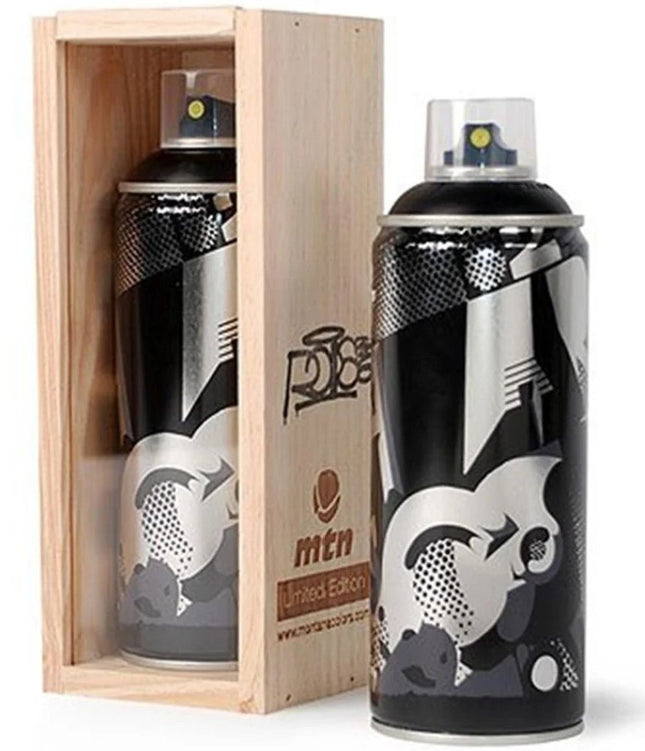
Roid Roid Black Spray Paint Can Artwork by Montana MTN
Roid- Black Limited Edition Rare Spray Paint Can Artwork Crossover by famous graffiti paint maker Montana MTN. Born in 82, London Based artist Roid began painting in the late 90’s spending the last ten years building a solid in- international reputation for innovation and technical skill. His constant evolution of the conventions of New York Subway graffiti has never stayed still and neither has he. After his sellout debut solo show in summer 2012 he is now working as a fine artist and creative director from his south London studio, continuing to influence and change the way people think about graffiti.
$218.00
-
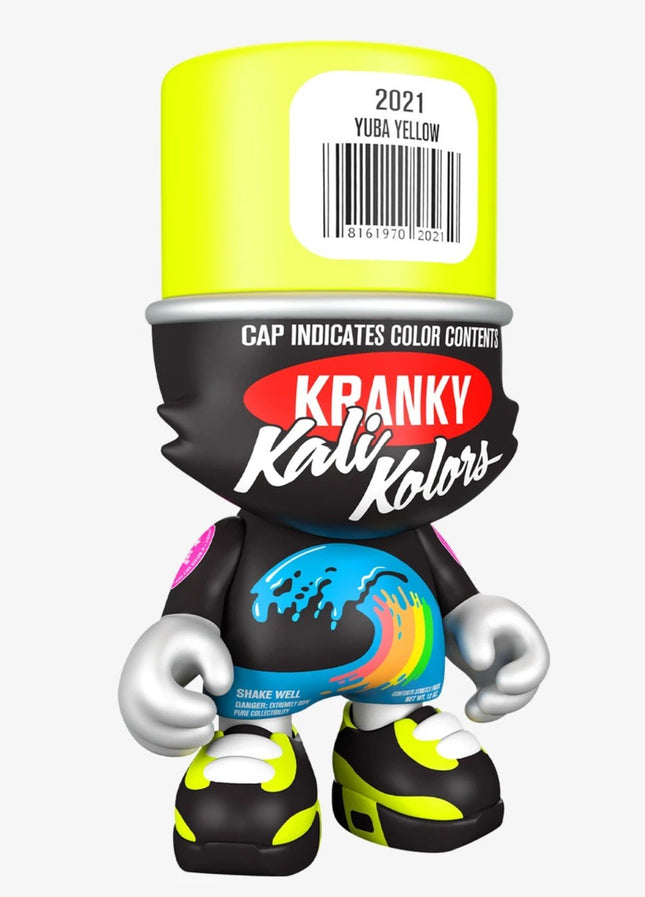
Sket-One Yuba Yellow SuperKranky Art Toy by Sket- One x SuperPlastic
Ramona Red SuperKranky Janky SuperPlastic x Sket One Limited Edition Vinyl Artwork Street Art Toy Collectable Figure 2021 Limited Edition of 1444 Nozzle, removable cap & that OG RATTLE, 1444 made 2021
$291.00
-
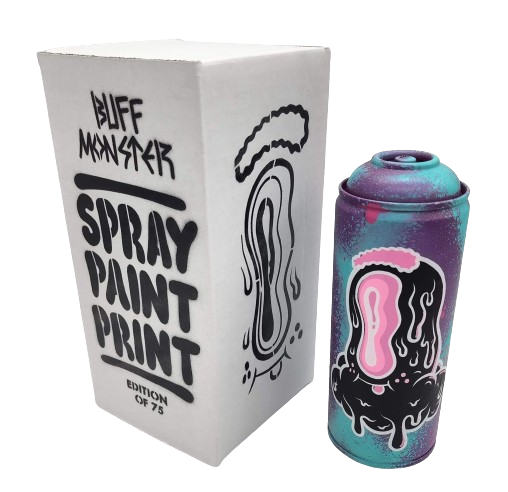
Buff Monster Melty Misfit Eye Drip- Purple/Blue Spray Paint Can by Buff Monster
Melty Misfit Eye Drip- Purple/Blue HPM Embellished Spray Paint Can Sculpture Artwork by Iconic Pop Culture Modern Artist Buff Monster. 22022 Signed Limited Edition of 75 HPM Silkscreen & Spray Paint Hand-Embellished HPM Each Unique In Silkscreened Box, Displayed With Box. Buff Monster's Creative Process The "Melty Misfit Eye Drip" purple/blue HPM embellished spray paint can sculpture is a vibrant and thought-provoking piece by the iconic modern pop culture artist Buff Monster. Known for his signature style that encompasses a pastel-hued palette and a unique blend of influences from street pop art, graffiti artwork, and Japanese culture, Buff Monster's works are instantly recognizable. This particular creation, part of a signed limited edition of 75, is a testament to the artist's creative vision and the innovative spirit of street art. Buff Monster's "Melty Misfit Eye Drip" in purple and blue is a hand-embellished work that defies the traditional boundaries of street art. Each can is meticulously spray-painted and silkscreened by hand, ensuring every piece in the series is unique. The artist's dedication to his craft is evident in the intricate detailing and precision of the silkscreen prints. His choice of purple and blue hues for this series evokes a sense of the mystical and the fantastical, two elements often found in his work. Symbolism in "Melty Misfit Eye Drip" The imagery of the melting eye is a recurrent theme in Buff Monster's work, symbolizing the fluid and ever-changing nature of life and perception. The dripping motif is reminiscent of the melting clocks in Salvador Dalí's surrealist paintings, suggesting a distortion of time and reality. In graffiti artwork, this motif resonates with the temporary nature of the urban landscape, where art is constantly being created and recreated. Cultural Resonance and Collectability The "Melty Misfit Eye Drip" series resonates with the DIY ethos of street art culture, where artists take control of the means of production and distribution. Including a silkscreened box with each spray paint can sculpture underscores Buff Monster's comprehensive approach to his art, considering the piece itself and its presentation and preservation. The box serves both a practical and aesthetic purpose, enhancing the collectability of the piece and reaffirming its status as a piece of high art within the domain of street pop art. Buff Monster's Impact on Modern Art Buff Monster has significantly impacted the contemporary art scene, particularly within the genres of street pop art and graffiti artwork. His works are characterized by their bold use of color, playful yet provocative themes, and seamless blend of street art techniques with acceptable art practices. The "Melty Misfit Eye Drip" purple/blue HPM is a prime example of how Buff Monster continues to innovate within his medium, pushing the boundaries of what is possible within art collectibles. Buff Monster's "Melty Misfit Eye Drip" purple/blue HPM spray paint can sculpture is a collectible that captures the heart of street pop art and graffiti artwork. Each hand-embellished piece uniquely expresses Buff Monster's artistic vision, embodying the transformative power of art and its ability to challenge and redefine cultural norms. This series reflects the artist's mastery of his medium and his role as a significant influence in the evolving narrative of modern art.
$541.00
-
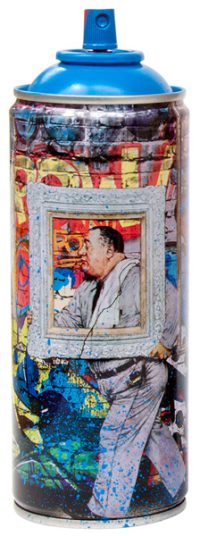
Mr Brainwash- Thierry Guetta Wall Frame Cyan Spray Paint Can Sculpture by Mr Brainwash- Thierry Guetta
2020 Signed Via Thumbprint & Numbered With Custom Display Box. Wall Frame- Cyan Limited Edition Spray Paint Can Sculpture Artwork by street artist graffiti & pop culture legend Mr Brainwash- Thierry Guetta. 2020 Signed & Numbered Limited Edition of 150 Artwork Size 3x8 Signed Via Thumbprint & Numbered With Custom Display Box. Ultra rare and very cool Mr Brainwash- Thierry Guetta limited edition spray paint can artwork collectibles.
$504.00
-
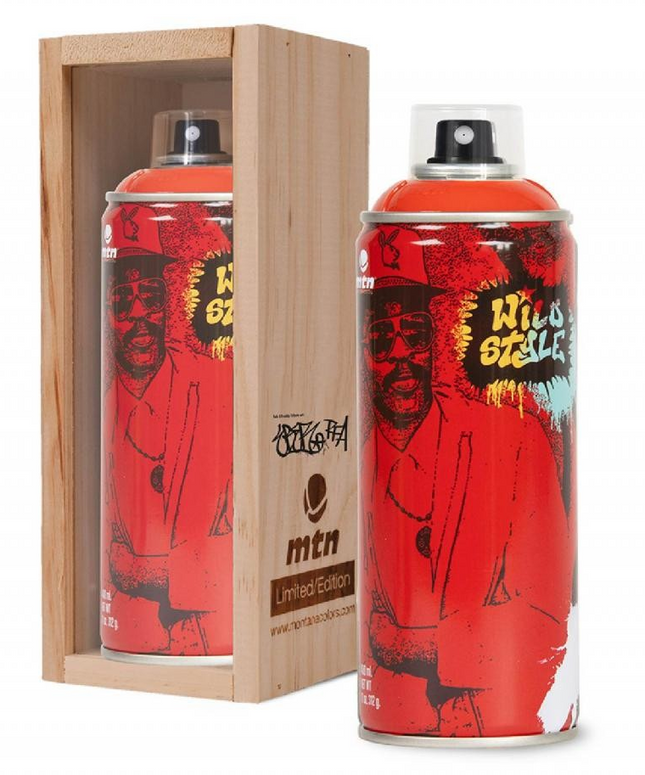
Fab 5 Freddy- Fred Brathwaite Fab 5 Colorado Red Wildstyle Spray Paint Can Artwork by Montana MTN
Fab 5 Colorado Red Spray Paint Can Artwork by Fab 5 Freddy- Fred Brathwaite x Montana MTN Limited Edition Artist Paint Crossover Graffiti Street Object Art. 2024 Fab 5 Colorado Red Color Limited Edition of 500 Spray Paint Can with Custom Wood Box Object Artwork Size 3x8 Montana MTN Filled with Paint. Wildstyle Rapper Musician Artist Fab 5 Freddy African American Man Vintage Style Photo Stylized Graffiti Spray Paint Can Art. Fab 5 Freddy and Montana MTN: A Spray Can Revolution The collaboration between Fab 5 Freddy, born Fred Brathwaite, and Montana MTN in 2024 produced a unique artifact that fuses the energy of street art with the essence of collectible design. The "Fab 5 Colorado Red" spray paint can is not just a tool for creating graffiti but a standalone piece of art. With only 500 made, each can is a limited edition work that captures the spirit of Fab 5 Freddy's influence on graffiti and hip-hop culture. The custom wood box packaging elevates the can from a simple container of paint to an object of art, underscoring the importance of presentation in the world of art collectibles. Each can, sized at a modest 3x8 inches, is filled with the vibrant "Colorado Red" hue of paint, a nod to the bold and impactful color choices often made by graffiti artists. The design of the can features a vintage-style photo of an African American man, representing Fab 5 Freddy himself, stylized in a way that marries graffiti's wildstyle lettering with a classic portrait. This design encapsulates Fab 5 Freddy's legacy within the worlds of street pop art and graffiti artwork, bridging the divide between the street and the gallery. Legacy of Wildstyle: Fab 5 Freddy's Impact on Graffiti Art Fab 5 Freddy's contributions to the culture of graffiti are monumental. He was among the first to bring graffiti and hip-hop from the streets of New York to a global audience, transforming the perceptions of graffiti from acts of vandalism to recognized forms of art. His wildstyle graffiti, characterized by intricate, interlocking letters and symbols, was revolutionary, influencing countless artists and cementing his place in street art history. The "Fab 5 Colorado Red" spray paint can artwork continues this legacy, serving as a tribute to the style and influence of Fab 5 Freddy. The can’s artwork tells a story of the streets, of the evolution of graffiti as an art form, and of the man who helped propel it into the cultural mainstream. Each limited edition can is a celebration of the history and progression of street pop art, embodying the creative spirit that Fab 5 Freddy represented. The Art Object Phenomenon: From Utility to Icon The phenomenon of transforming utilitarian objects like spray paint cans into icons of art has become increasingly prevalent in the world of pop graffiti and street art. These objects, once solely seen as the tools of the trade for street artists, have become canvases in their own right, offering artists a new medium to express their vision. The "Fab 5 Colorado Red" spray paint can by Montana MTN is a prime example of this trend, where the object itself becomes a piece of art, coveted by collectors and enthusiasts alike. The collaboration between Fab 5 Freddy and Montana MTN is more than a business venture; it's a symbolic convergence of art and utility, of the street and the establishment. Each can, with its vibrant color and striking design, is a testament to the power of street art to innovate and inspire, to transcend its roots and become an integral part of the art world’s lexicon. These limited edition cans are not only vessels of paint but vessels of history, carrying the legacy of street pop art and graffiti artwork forward for new generations to discover and appreciate. In the art community, collaborations like the "Fab 5 Colorado Red" are reminders of the transformative power of art, of its ability to reshape objects and perceptions. They stand as monuments to the artists like Fab 5 Freddy who have paved the way for the recognition and celebration of street art, ensuring that the essence of the streets—the bold, unapologetic voice of the graffiti artist—continues to be a vital part of the conversation in the world of art.
$239.00
-
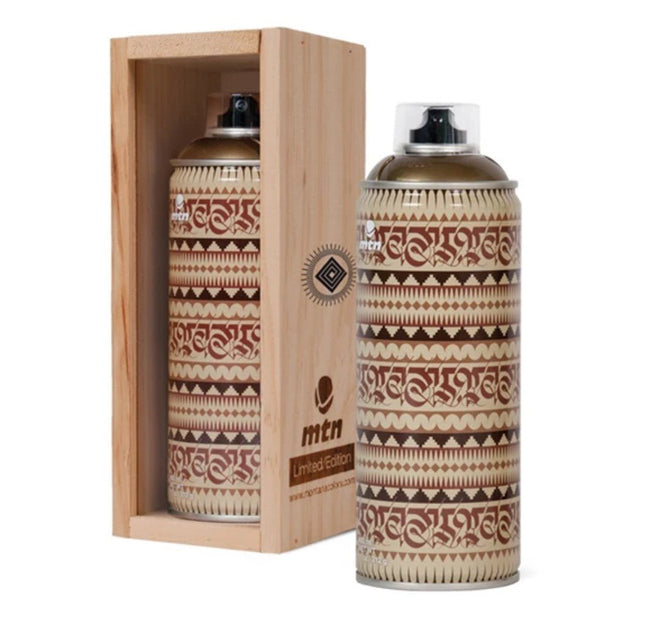
Cryptik Cryptik Gold Spray Paint Can Artwork by Montana MTN
Cryptik- Gold Limited Edition Rare Spray Paint Can Artwork Crossover by famous graffiti paint maker Montana MTN. CRYPTIK, a Los Angeles-based artist, creates works of art that explore the realm of spirituality and consciousness. His signature style of calligraphy, along with his iconic depictions of deities and spiritual consciousness. His signature style of calligraphy, along with his iconic depictions of deities and spiritual leaders, can be seen throughout the world, adorning the urban landscape and galleries alike. The goal of his leaders can be seen throughout the world, adorning the urban landscape and galleries alike. The goal of his art is to challenge people to think of other possibilities and to see a different reality; one that encompasses art is to challenge people to think of other possibilities and to see a different reality; one that encompasses many ideologies, philosophies, and belief systems in order to help us better understand our place in the many ideologies, philosophies, and belief systems in order to help us better understand our place in the universe.
$218.00
-
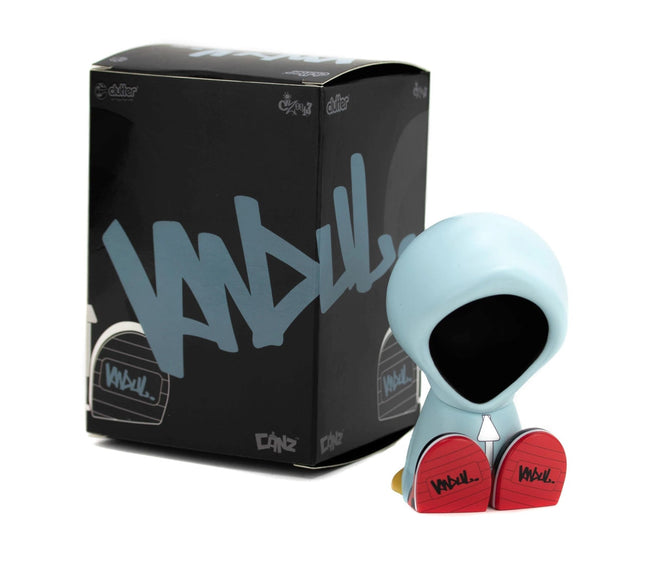
Vandul VandulBot- Light Blue Canbot Canz Art Toy Figure by Vandul x Czee13
VandulBot- Light Blue Canbot Canz Limited Edition Vinyl Art Toy Collectible Artwork by street graffiti Vandul. 2021 Limited Edition of 150 Displayed In Box The enigmatic, elusive, and mysterious, LA-based street artist, Vandul, has collaborated with UK legend Czee13 to bring you his second entry into the Canz Universe, the VANDUL-BOT! The Vandul-Bot Light Blue Edition measures 5.5” tall and is limited to 150 pieces worldwide.
$200.00
-
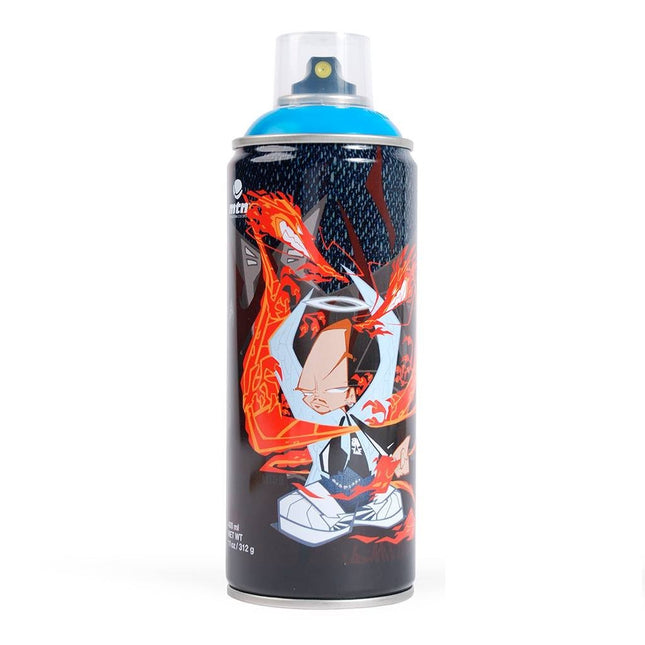
Mistery Mistery Avatar Blue Spray Paint Can Artwork by Montana MTN
Mistery- Avatar Blue Limited Edition Rare Spray Paint Can Artwork Crossover by famous graffiti paint maker Montana MTN. Mistery has been one of Australia’s most long-standing and influential writers. Starting out as a B-boy in the early 1980’s he continues to represent the Hip Hop culture through Breakin, Graff & as an Emcee. Although known for his signature B-boy characters Mistery still maintains that graff is about letterforms, and accordingly continues to perfect his style. Painting in every corner of the globe Mistery has definitely made his mark. A B-boy, Martial Artist, Christian Minister, Emcee & Writer, Mistery is an enigma.
$218.00
-
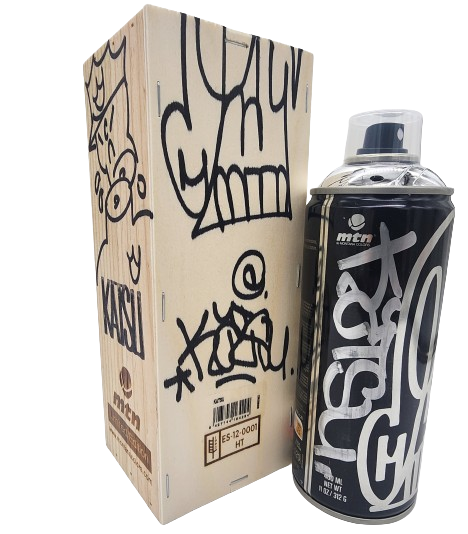
Katsu Katsu Tagged Signed Silver Chrome Spray Paint Can Artwork by Montana MTN
Katsu Hand Tagged & Signed Silver Chrome Spray Paint Can Artwork by Montana MTN Limited Edition Crossover. 2023 Signed Katsu Silver Chrome Spray Paint Can Signed Box Limited Edition of ??? Out of 500 Artwork Size 3x8 Can. Both can and wooden boxes are hand-signed, tagged, and drawn on with spray paint. The Katsu Hand Tagged & Signed Silver Chrome Spray Paint Can is a collectible piece that melds the rebellious spirit of graffiti with the exclusivity of limited edition art. Presented in a partnership with Montana MTN, a brand synonymous with high-quality spray paint favored by street artists worldwide, this 2023 release encapsulates the essence of urban art in a tangible form. Encased within a wooden box, each spray paint can measure 3x8 inches and comes hand-signed by the artist Katsu, a pseudonymous figure revered in the underground art community. The signing of the can and the box not only authenticates each piece but also incorporates Katsu's signature style directly onto the objects, making every edition unique. This series, limited to an undisclosed number out of 500, stands as a coveted item for collectors and enthusiasts of street culture. The iconic Katsu tag, typically seen in public spaces as an act of reclaiming territory and self-expression, is recontextualized here as a collectible art form. This crossover between street and collectible art challenges traditional perceptions of graffiti as mere vandalism, elevating it to a form of pop art that can be admired and owned. The chrome finish on the cans reflects the quintessential look of graffiti art as it glistens on city walls, capturing the fleeting nature of such works, which often disappear as quickly as they appear. Each can and box, adorned with spray paint, carries the gritty textures and raw aesthetic found on the streets, offering a piece of the urban landscape to be appreciated within the sanctity of personal spaces. It's a dialogue between the artist and the collector, a signed contract that art is not confined to galleries and museums but is all around us, in the alleys and on the boulevards, alive in the places we pass every day. This series by Katsu and Montana MTN immortalizes the transient art of tagging, granting permanence to what is typically ephemeral and providing a narrative of contemporary art's evolution.
$620.00
-
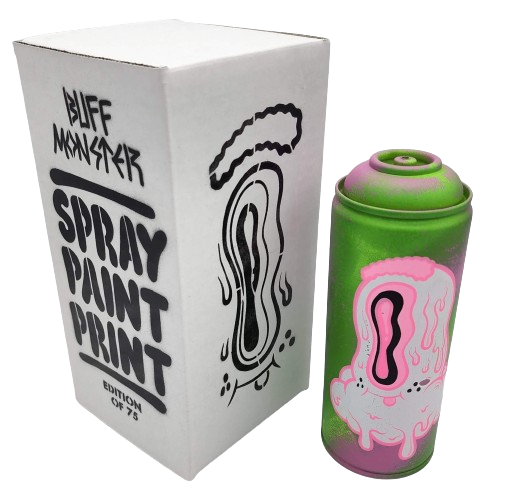
Buff Monster Melty Misfit Eye Drip- Pink/Green Spray Paint Can by Buff Monster
Melty Misfit Eye Drip- Pink/Green HPM Embellished Spray Paint Can Sculpture Artwork by Iconic Pop Culture Modern Artist Buff Monster. 2022 Signed Limited Edition of 75 HPM Silkscreen & Spray Paint Hand-Embellished HPM Each Unique In Silkscreened Box, Displayed With Box. Artistic Innovation in "Melty Misfit Eye Drip" The "Melty Misfit Eye Drip" pink/green HPM (Hand-Painted Multiple) is an intricately embellished spray paint can sculpture that showcases the bold and distinctive style of Buff Monster, an iconic pop culture modern artist. This limited edition piece, a vivid representation of the vibrant street pop art and graffiti artwork movement, is a fusion of delicate art sensibilities and the rebellious spirit of street art, encapsulating the playful yet thought-provoking essence of Buff Monster's oeuvre. Buff Monster's "Melty Misfit Eye Drip" is a unique contribution to art collectibles. This 2022 series, limited to a signed edition of 75, elevates the everyday spray paint can to a piece of art. Each can is meticulously hand-embellished, employing a combination of silkscreen and spray paint techniques, which ensures that no two pieces in the series are identical. The artist's choice of bright pink and green is reflective of his signature color palette, often inspired by the flavors and spirit of ice cream—a recurring motif in his work. The melty appearance of the eye design gives the impression of dripping paint, a nod to the fluidity and transformative nature of graffiti art. Craftsmanship and Presentation The high level of craftsmanship involved in creating "Melty Misfit Eye Drip" is evident in the precision of the silkscreen print and the careful hand-finishing that brings each piece to life. Buff Monster's dedication to quality is further emphasized by the silkscreened box accompanying each can, creating a cohesive display piece. The box, featuring a similar design to the can itself, not only protects the artwork but also adds a layer of aesthetic appeal, making it an integral part of the overall presentation. This attention to detail in presentation is a hallmark of Buff Monster's work, resonating with collectors who appreciate visually striking and meticulously crafted art. Buff Monster's Cultural Impact Buff Monster has long been a prominent figure in the street art scene, with his work appearing in cities worldwide. His contribution to the field of street pop art is significant, with a visual language that is instantly recognizable and often imitated. The "Melty Misfit Eye Drip" series continues its impact on the culture, blending the subversive energy of graffiti with the polish of fine art. His works are often seen as a celebration of the transient nature of street art while also challenging the idea that such art is disposable or temporary. Like much of his work, this piece bridges the gap between the gallery and the street, inviting a broader audience to engage with and appreciate the art form. Collectability and the Art Market The limited edition nature of "Melty Misfit Eye Drip," coupled with Buff Monster's reputation in the art world, contributes to the desirability and collectability of the piece. As an investment, Buff Monster's works have been known to appreciate over time, reflecting the growing interest in street pop art and graffiti artwork within the art market. The artist's signature on each piece is a testament to its authenticity, and the limited run enhances its value for collectors. Making each piece by hand and including a silkscreened box speaks to the artist's commitment to producing work that stands the test of time, both in terms of style and substance. Buff Monster's "Melty Misfit Eye Drip" HPM spray paint can sculpture embodies the convergence of street art's spontaneity and the fine art world's attention to detail. It's a testament to the artist's standing as a transformative figure in modern pop culture and street art. Through his distinctive aesthetic and innovative approach to his medium, Buff Monster continues to push the boundaries and challenge perceptions of what graffiti artwork can be, making his pieces a significant part of the contemporary art landscape.
$541.00
-
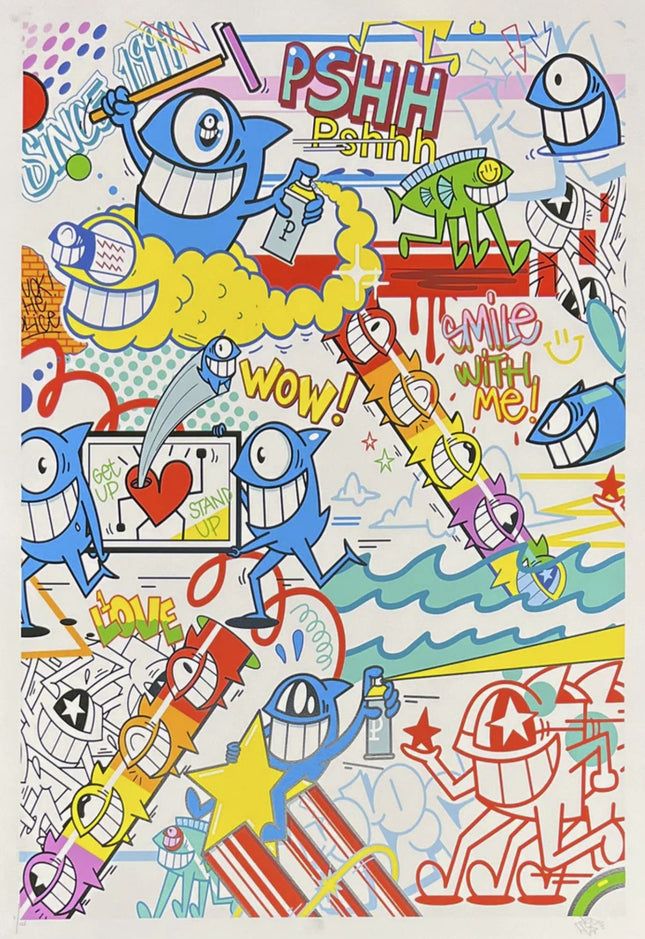
El Pez Get Up Stand Up Silkscreen by El Pez
Get Up Stand Up Silkscreen by El Pez Hand-Pulled 16-Color Screen Print on 300gsm Somerset Satin Paper Limited Edition Pop Street Art Artwork. 2022 Signed & Numbered Limited Edition of 125 Artwork Size 21.65x29.52 16 Colour Screen Print on Somerset 300 gsm paper Edition of 125 signed by the artist 75 x 55 cm 2022
$495.00
-
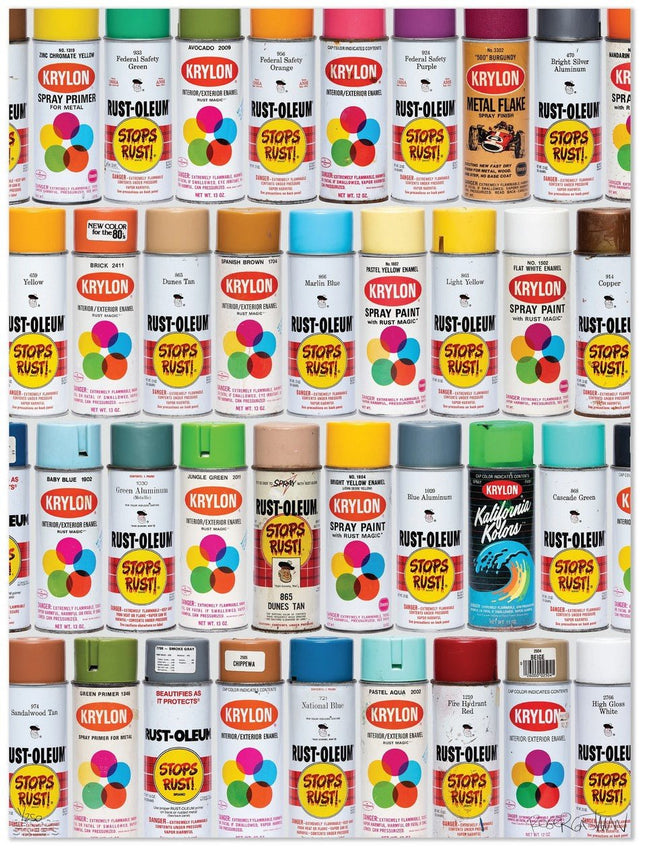
Roger Gastman Don't Draw Dirty Pictures 1 Giclee Print by Roger Gastman
Don't Draw Dirty Pictures 1 Artwork Giclee Limited Edition Print on 305gsm Archival Cold Press Cotton Rag Print by Pop Culture Graffiti Artist Roger Gastman. Roger Gastman Don't Draw Dirty Pictures 1 18" x 20" Pigment Print on Archival Cold Press Cotton Rag 305 GSM Edition of 250 Signed and numbered by Roger Gastman
$226.00
-
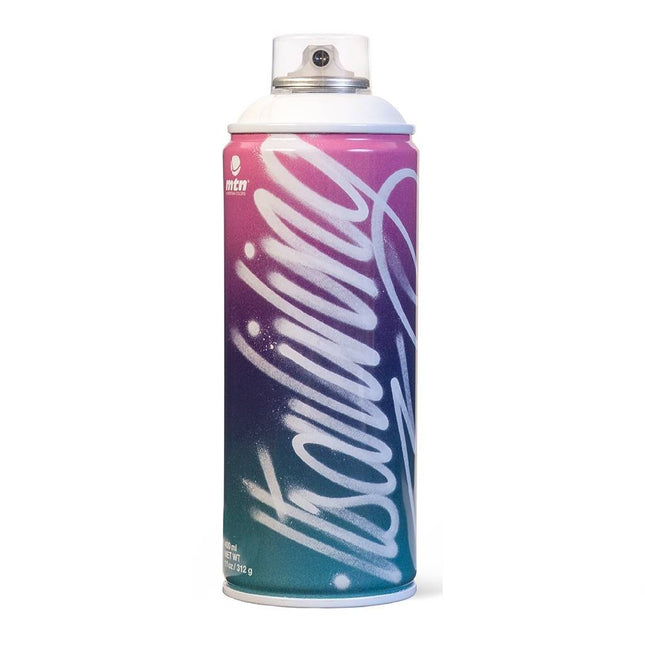
It´s a Living It´s a Living White Spray Paint Can Artwork by Montana MTN
It´s a Living- White Limited Edition Rare Spray Paint Can Artwork Crossover by famous graffiti paint maker Montana MTN. IT’S A LIVING is not just a statement but it is also a life philosophy for Ricardo Gonzalez, a designer, and artist from Durango México currently living in Brooklyn. His signature script style can be easily recognized from large-scale murals to commercial work for some of the biggest brands to a simple sticker in the streets. The ambiguity in the typographical messages continually creates a dialog between the viewer and the artwork. “A word is an image” and an image can be interpreted in so many ways, the direct approach of typography has been an exploring path where the main goal is to question our daily living and to produce a positive impact. After all, it’s a living.
$218.00
-
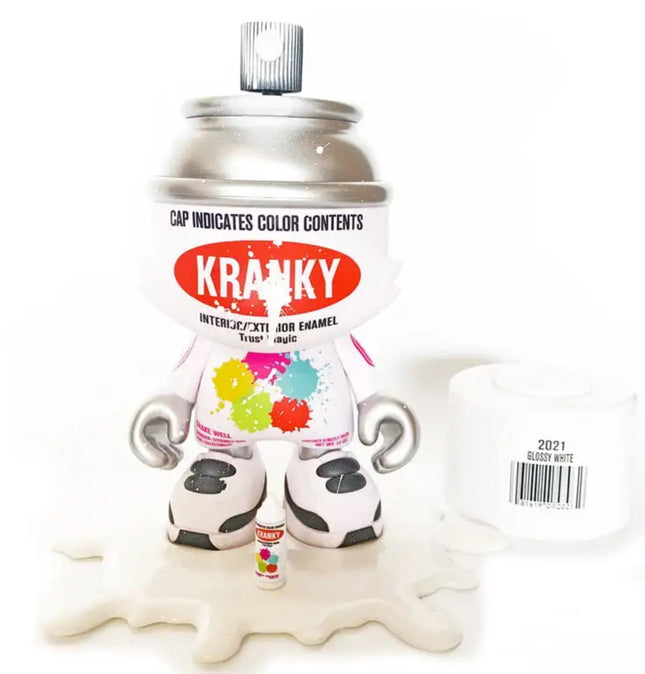
Sket-One Glossy White AP SuperKranky HPM Art Toy by Sket- One x SuperPlastic
Glossy White Artist Proof SuperKranky Set Limited Edition Vinyl Artwork Street Art Toy Collectable Figure by Sket- One AP Artist Proof 2022 Signed & Numbered Edition of Only 10 Jankey Superplastic Custom Super Kranky Hand Made Parts by Sket One. Comes Hand Embleshied with Paint Pool Underlayment 7 Mini Spray Can Element. These pieces come with: Custom paint splatter (Each one will be unique) 3d Resin Puddle Place Matt Resin Kranky Spraycan Signed and Numbered on Cap
$572.00
-

Risk Rock RISK-OLEUM Red Signed The Canmans 213 Art Toy by Risk Rock x Comikaze
Signed RISK-OLEUM Red Dawn of The Canmans Artist Edition 213 Vinyl Art Toy by Risk Rock x Comikaze Limited Edition Collectible Sculpture Figure Fine Artwork by Graffiti Pop Street Artist. 2013 Signed on Box Limited Edition of 200 Artwork Size 4x7 New In Box Stamped Vinyl Fine Art Toy Riskoleum Figure Sculpture. Mad Society Kings, Art Work Rebels, Angels Will Rise, West Coast Artists (AWR/MSK/TSL/WCA) Graffiti Street Artist Risk Rock. Vinyl Figure with Moveable Arms and a Detachable Top that Pops Off to Reveal Hollow Storage Inside. Signed RISK-OLEUM Red Canman 213 by Risk Rock in Street Pop Art & Graffiti Artwork The Signed RISK-OLEUM Red Canman 213 Artist Edition is a limited vinyl art figure created in 2013 by Los Angeles graffiti artist Kelly Graval, known as Risk Rock. Released in partnership with Comikaze, this collectible piece was part of a limited run of only 200 units and features Risk’s signature on the box, making it a rare item for collectors of graffiti-influenced art toys. Designed to resemble a classic aerosol spray can brought to life with arms, feet, and a removable top, the figure merges sculptural function with the visual language of graffiti culture. Standing approximately 7 inches tall and constructed from vinyl, the RISK-OLEUM figure pays homage to the tools of graffiti while acting as a stylized character with distinct urban identity. This particular edition, labeled 213 Risk Rock Red, not only references Risk’s area code but solidifies the artwork as a physical representation of his legacy in Street Pop Art & Graffiti Artwork. Design Language, Functionality, and Packaging This vinyl figure draws directly from the aesthetic of traditional spray paint brands while layering in iconography from Risk’s personal visual vocabulary. The figure features a red plaid pattern wrapped around the midsection, mimicking product branding while referencing punk influences and West Coast graffiti styling. The blood-red gloves, paint-splattered feet, and mischievous devil icon on the front give the figure a defiant presence. Its moveable arms and detachable cap reveal a hollow interior, allowing it to double as both sculpture and storage piece. The edition’s packaging further elevates its status, with the figure displayed in a custom-printed box labeled Dawn of The Canmans, and Risk’s bold tag scrawled across the exterior, transforming the box into part of the art. These design elements highlight how form, message, and collectibility come together in the Street Pop Art & Graffiti Artwork genre. Graffiti Crew Affiliations and Cultural Significance Risk Rock is a long-standing figure in the Los Angeles graffiti movement and a founding member of several of the region’s most respected crews, including AWR (Art Work Rebels), MSK (Mad Society Kings), WCA (West Coast Artists), and TSL (The Seventh Letter). His contribution to graffiti culture spans decades and has included freeway takeovers, large-scale murals, fine art exhibitions, and designer collaborations. This figure embodies that history, with references to Risk’s crews prominently displayed on the back of the piece. The inclusion of multiple crew names solidifies the Canman as not just a toy, but a miniature archive of West Coast graffiti history. Each detail reflects Risk’s role as both an innovator and historian within the movement. Limited Edition Status and Collector Relevance As a signed and numbered edition of only 200 units, the RISK-OLEUM Red Canman 213 holds significant value in the collectible art market. The combination of artist-authenticated packaging, functional design, and deep cultural references makes this piece a highly sought-after item among collectors of graffiti memorabilia, vinyl figures, and pop-influenced sculpture. It stands as a physical artifact that merges the legacy of spray can art with the expanding universe of Street Pop Art & Graffiti Artwork. With its signature, interactive design, and cultural roots, the figure continues to represent the fusion of street tradition and contemporary art form. Risk’s ability to move fluidly between the street, the gallery, and the art toy world is perfectly captured in this edition, offering collectors an authentic and highly stylized piece of graffiti history.
$350.00 $300.00
-
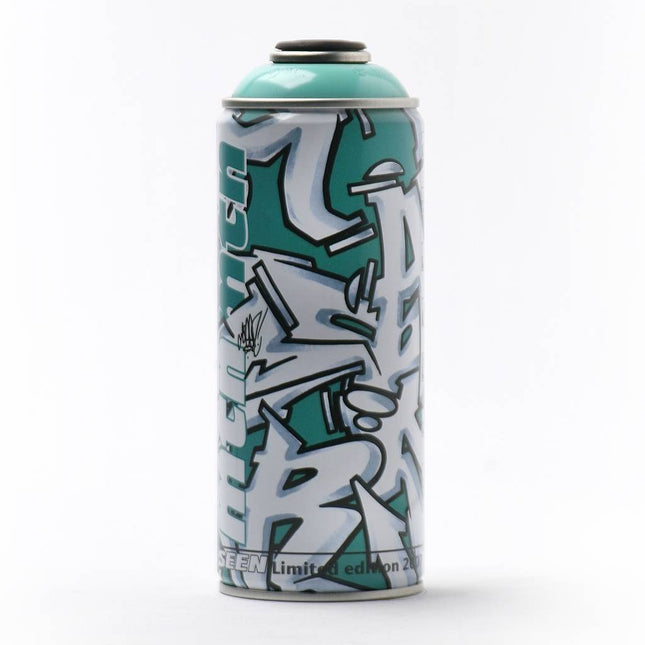
Seen UA Seen Cascade Green No Box Spray Paint Can Artwork by Montana MTN
Seen UA- Cascade Green Limited Edition Rare Spray Paint Can Artwork Crossover by famous graffiti paint maker Montana MTN. - No Box Writer, illustrator, and tattooist, he has maintained a development linked to the world of graffiti that has served as an example to thousands of young people around the world. He was in NYC in the late 1970s, he was part of the generation that made graffiti a popular phenomenon and enjoys, to this day, representation around the world. Long live graffiti godfather. Living legend.
$218.00
-
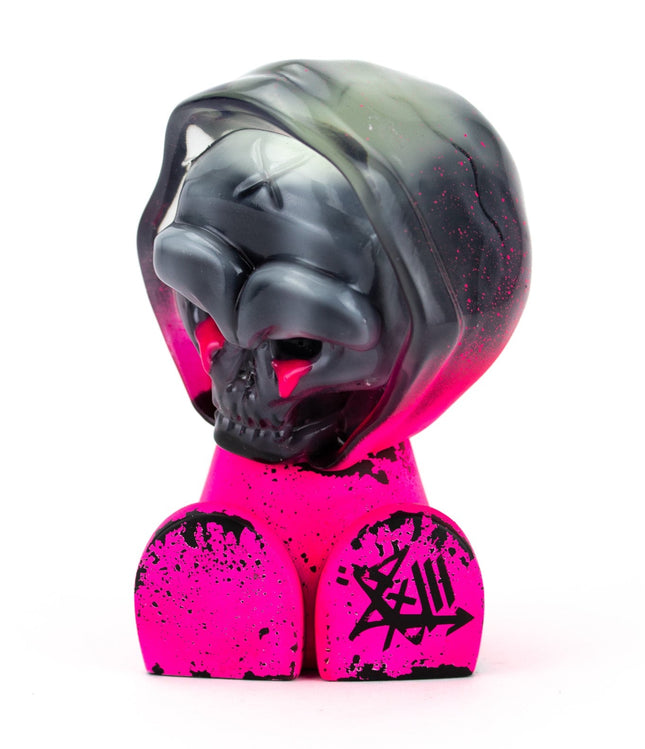
5thTurtle Deadbotz Canbot- Pink Art Toy by 5thTurtle x Czee13
Deadbotz Canbot Canz - Pink Limited Edition Hand Painted Vinyl Art Toy Collectible Artwork by Pop Culture Artists 5thTurtle x Czee13. 2022 Hand Painted Limited Edition of 20 New, Did Not Come With Retail Packaging. This 5oz canbot has a double-cast, Glow-in-the-dark, Dead Dreamer head on vinyl canbot body. Hand-painted by Czee13 with UV reactive plaint. Limited run of 20
$499.00
-
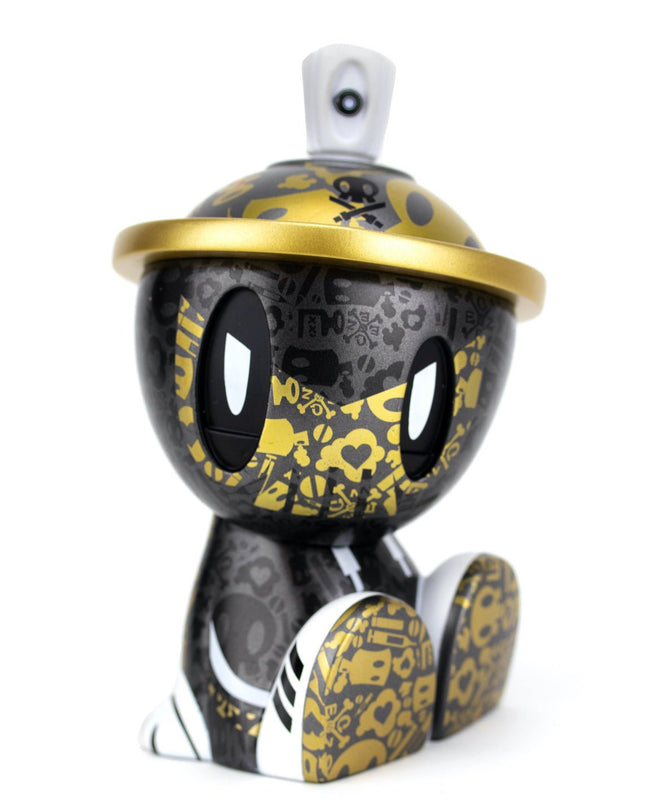
Quiccs VSOG Gold Canbot Canz Art Toy Figure by Quiccs x Czee13
VSOG Gold Canbot Canz Limited Edition Vinyl Art Toy Collectible Artwork by street graffiti Czee13 x Quiccs. 2021 Limited Edition of 300 The VSOG Gold Canbot Canz Vinyl Figure by Quiccs x Czee13 x Clutter x NTWRKCheck out this rad-looking VSOG Gold Canbot Canz vinyl figure, the ultimate crossover between Czee13s Canbot Canz and Quiccss Lil Qwiky design! This might just be the most luxurious colorway of the Canbot Canz ever created. Produced by Clutter, the VSOG Gold Canbot Canz features Czee13s trademark OG pattern perfectly wrapped and merged into Quiccs Lil Qwiky design. Printed in metallic paints, the detailing on this Canbot Canz is gorgeous and is truly a work of art. There will only ever be two colorways of this design made, and it is guaranteed to be the highlight of your collection! Each figure stands 5.5 tall and features its trademark rattle. Limited to just 300 pieces!
$197.00
-
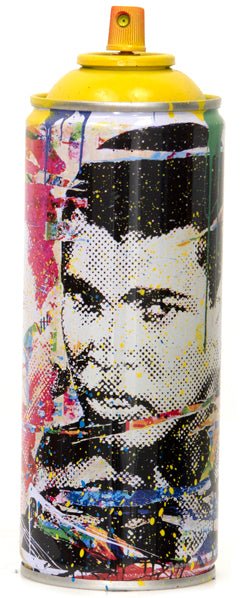
Mr Brainwash- Thierry Guetta Champ Yellow Spray Paint Can Sculpture by Mr Brainwash- Thierry Guetta
Champ- Yellow Limited Edition Spray Paint Can Sculpture Artwork by street artist graffiti & pop culture legend Mr Brainwash- Thierry Guetta. 2020 Signed & Numbered Limited Edition of 150 Artwork Size 3x8 Signed Via Thumbprint & Numbered With Custom Display Box. Ultra rare and collectible Mr Brainwash- Thierry Guetta limited edition spray paint can sports artwork boxing collectibles.
$504.00
-
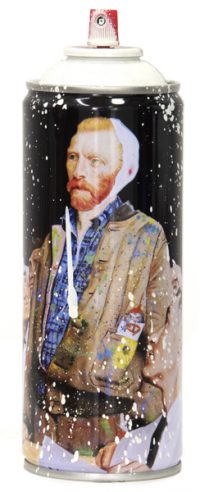
Mr Brainwash- Thierry Guetta Van Gogh White Spray Paint Can Sculpture by Mr Brainwash- Thierry Guetta
Van Gogh- White Limited Edition Spray Paint Can Sculpture Artwork by street artist graffiti & pop culture legend Mr Brainwash- Thierry Guetta. 2020 Signed & Numbered Limited Edition of 150 Artwork Size 3x8 Signed Via Thumbprint & Numbered With Custom Display Box. Ultra rare and very cool Mr Brainwash- Thierry Guetta limited edition spray paint can artwork collectibles.
$504.00
-
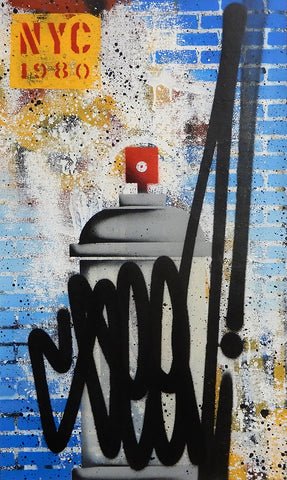
Seen UA Spray Can Raw Series 7897 Original Graffiti Painting by Seen UA
Spray Can Raw Series 7897 Original Graffiti Painting by Seen UA One-of-a-kind Spray Paint & Acrylic Painting Artwork on Stretched Canvas. 2022 Signed Original Stencil Multi Tags Series Acrylic & Spray Paint Painting Size 18x30 The artwork titled "Spray Can Raw Series 7897" is a distinctive original graffiti painting created by Seen UA, a revered figure in urban art. This piece is a one-of-a-kind fusion of spray paint and acrylic, boasting a raw energy that encapsulates the spirit of street pop art and graffiti artwork. Crafted in 2022, the painting is part of the Original Stencil Multi Tags Series, a collection that showcases the artist's adeptness in combining various elements of street art and fine art. Spanning a size of 18x30, the artwork is rendered on stretched canvas, a medium that offers a traditional touch to the otherwise rebellious art form. UA's signature is prominently featured, affirming the authenticity and originality of the piece. The use of spray cans, a hallmark tool in the graffiti world, is evident in the bold, swooping lines that dominate the visual field, lending a sense of movement and immediacy to the work. This piece reflects the broader aesthetic movements of pop art and graffiti, which have long been intertwined. Pop art's influence on graffiti is visible in the bright colors, the incorporation of commercial and urban imagery, and the emphasis on visual impact. Conversely, graffiti lends a raw, unfiltered voice to the polished surfaces of pop art, infusing it with a sense of urgency and authenticity. "Spray Can Raw Series 7897" exemplifies this cross-pollination, embodying the energy of the streets while holding its own as a piece of fine art. The result is a vibrant and thought-provoking piece that challenges boundaries and continues to shape the evolving narrative of contemporary art.
$1,124.00 $955.00
-
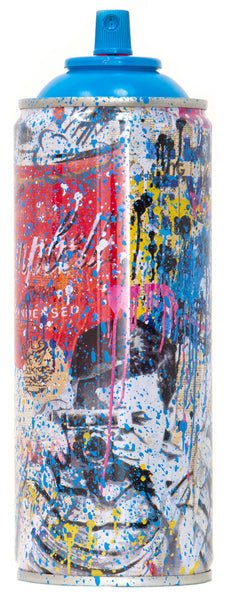
Mr Brainwash- Thierry Guetta Smile Portrait Cyan Spray Paint Can Sculpture by Mr Brainwash- Thierry Guetta
Smile Portrait- Cyan Limited Edition Spray Paint Can Sculpture Artwork by street artist graffiti & pop culture legend Mr Brainwash- Thierry Guetta. 2020 Signed & Numbered Limited Edition of 150 Artwork Size 3x8 Signed Via Thumbprint & Numbered With Custom Display Box. Ultra rare and very cool Mr Brainwash- Thierry Guetta limited edition spray paint can artwork collectibles.
$504.00
-
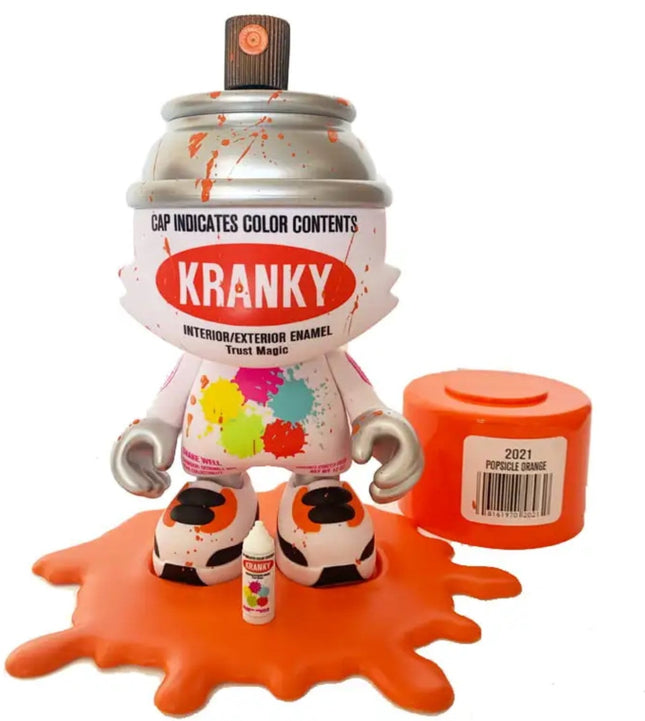
Sket-One Popsicle Orange AP SuperKranky HPM Art Toy by Sket- One x SuperPlastic
Popsicle Orange Artist Proof SuperKranky Set Limited Edition Vinyl Artwork Street Art Toy Collectable Figure by Sket- One AP Artist Proof 2022 Signed & Numbered Edition of Only 10 Jankey Superplastic Custom Super Kranky Hand Made Parts by Sket One. Comes Hand Embleshied with Paint Pool Underlayment 7 Mini Spray Can Element. These pieces come with: Custom paint splatter (Each one will be unique) 3d Resin Puddle Place Matt Resin Kranky Spraycan Signed and Numbered on Cap
$572.00
-
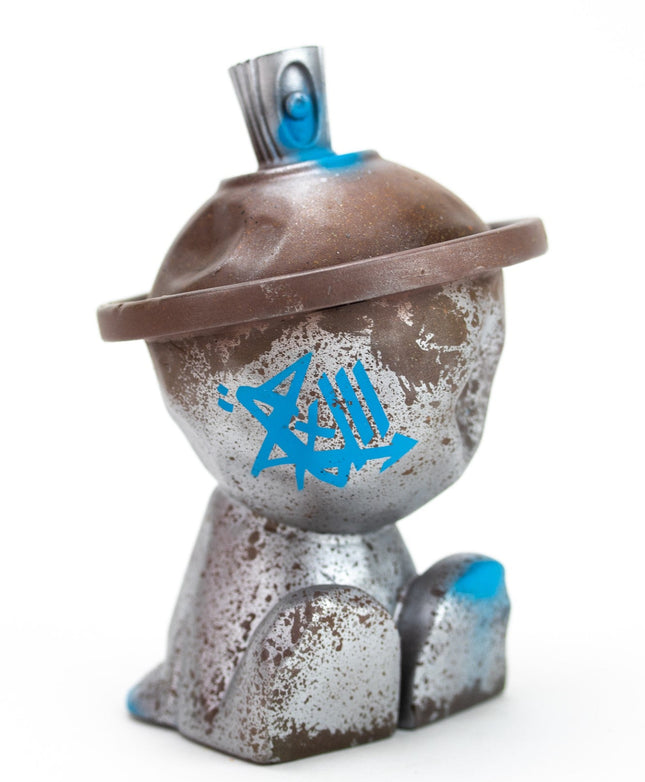
Czee13 5oz the Real OG #1 Original Canbot Canz Art Toy by Czee13
5oz the Real OG #1 Original Canbot Canz Original Hand Painted One of a Kind Spray Paint on Resin Art Toy Collectible Artwork by Pop Culture Artist Czee13. 2022 Signed Spray Paint Original Hand Painting on Canbot Canz 5oz Resin-cast crushed can design by Czee13. Cast in solid resin and hand-painted by Czee13. One-of-one.
$714.00
-
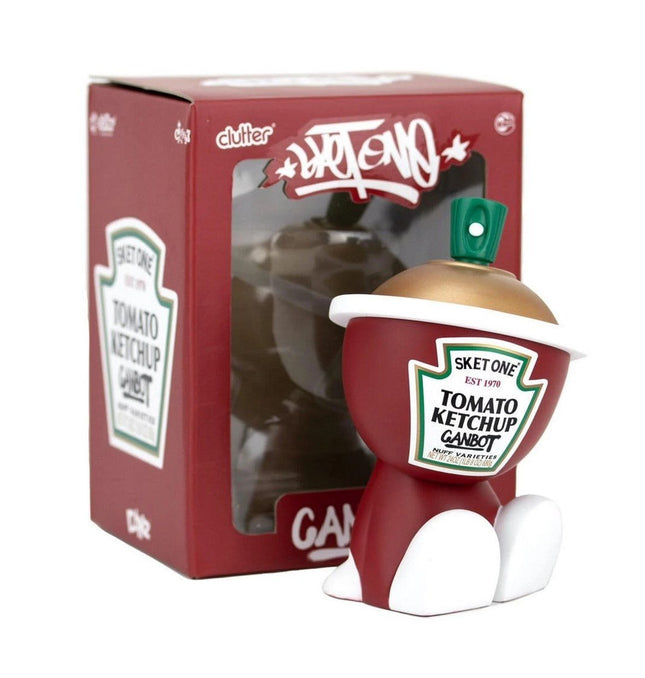
Sket-One Sketchup Canbot Canz Art Toy Figure by Sket-One x Czee13
Sketchup Canbot Canz Limited Edition Vinyl Art Toy Collectible Artwork by street graffiti Sket-One. Sketchup Canbot Canz by Sket-One x Clutter Magazine Legendary street artist Sket One, introduces us to the newest member of the Canz Family... The SKETCHUP! Taking one of his most loved designs and wrapping it onto the Canbot Canz platform by UK artist Czee13, collectors will be excited to see this design on a vinyl toy for the first time in over 10 years! Bringing together art, toys, food, and everything that gives us joy in life, Sket One’s Sketchup design is deliciously beautiful, and the perfect addition to any burger, or Canbot Canz collection! Standing at 5.5” with its trademark rattle.
$204.00
-
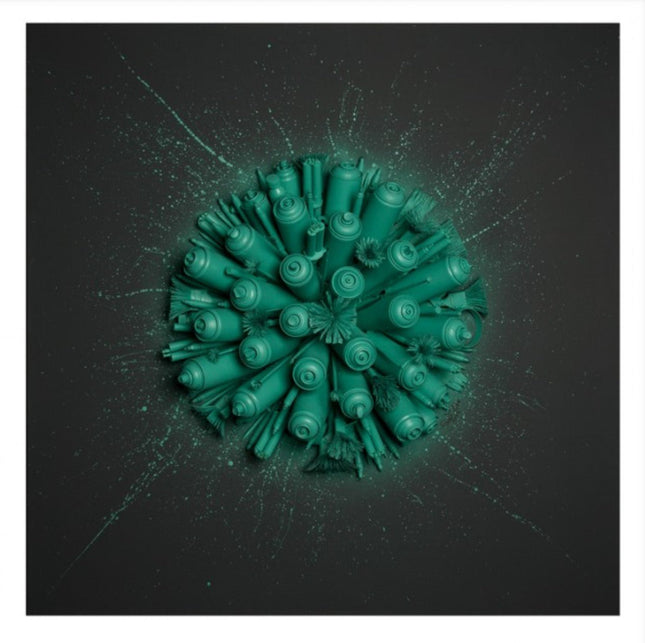
Saif Chilmiran Garbage Archival Print by Saif Chilmiran
Garbage Limited Edition Archival Pigment Prints on 310gsm Fine Art Paper by Saif Chilmiran Graffiti Street Artist Modern Pop Art. "This piece is part of the series, “Trash” which is currently on display at Courtyard Gallery as part of the “Pop Wall” exhibition. As a contemporary street art exhibition, my work corresponded to the gritty, do-it-yourself atmosphere of the collection. I think it fits well alongside the Dotmasters’ amazing stencils of trash bags since both series portray trash in different ways. Each of the originals took between 5 to 8 weeks. I use various elements from my garbage with some metalwork and plenty of epoxy. The items used are the disposable aftermath of my other works, taken from empty spray paint canisters, paintbrushes, markers, lighters and what happens to be occupying my workspace at the day." - Saif Chilmarin
$217.00
-
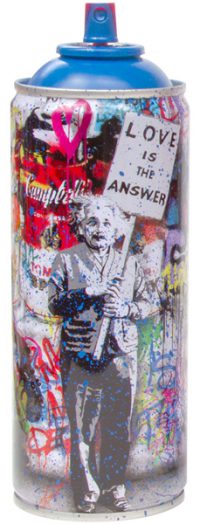
Mr Brainwash- Thierry Guetta Love is the Answer Cyan Spray Paint Can Sculpture by Mr Brainwash- Thierry Guetta
Love is the Answer- Cyan Limited Edition Spray Paint Can Sculpture Artwork by street artist graffiti & pop culture legend Mr Brainwash- Thierry Guetta. 2020 Signed & Numbered Limited Edition of 150 Artwork Size 3x8 Signed Via Thumbprint & Numbered With Custom Display Box. Ultra rare and very cool Mr Brainwash- Thierry Guetta limited edition spray paint can artwork collectibles.
$504.00

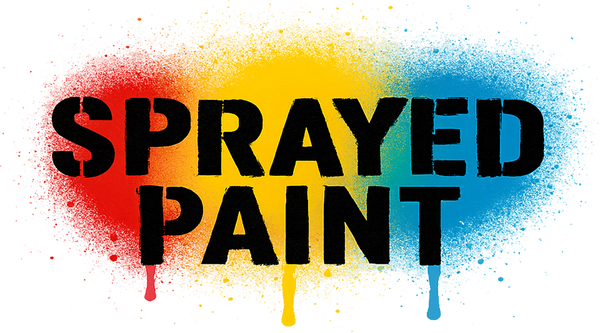











![[Not]WhiteChoc Bunnybot Canbot Canz Art Toy by Czee13](http://sprayedpaint.com/cdn/shop/products/notwhitechoc-bunnybot-canbot-canbot-818644.jpg?v=1667828553&width=645)



































